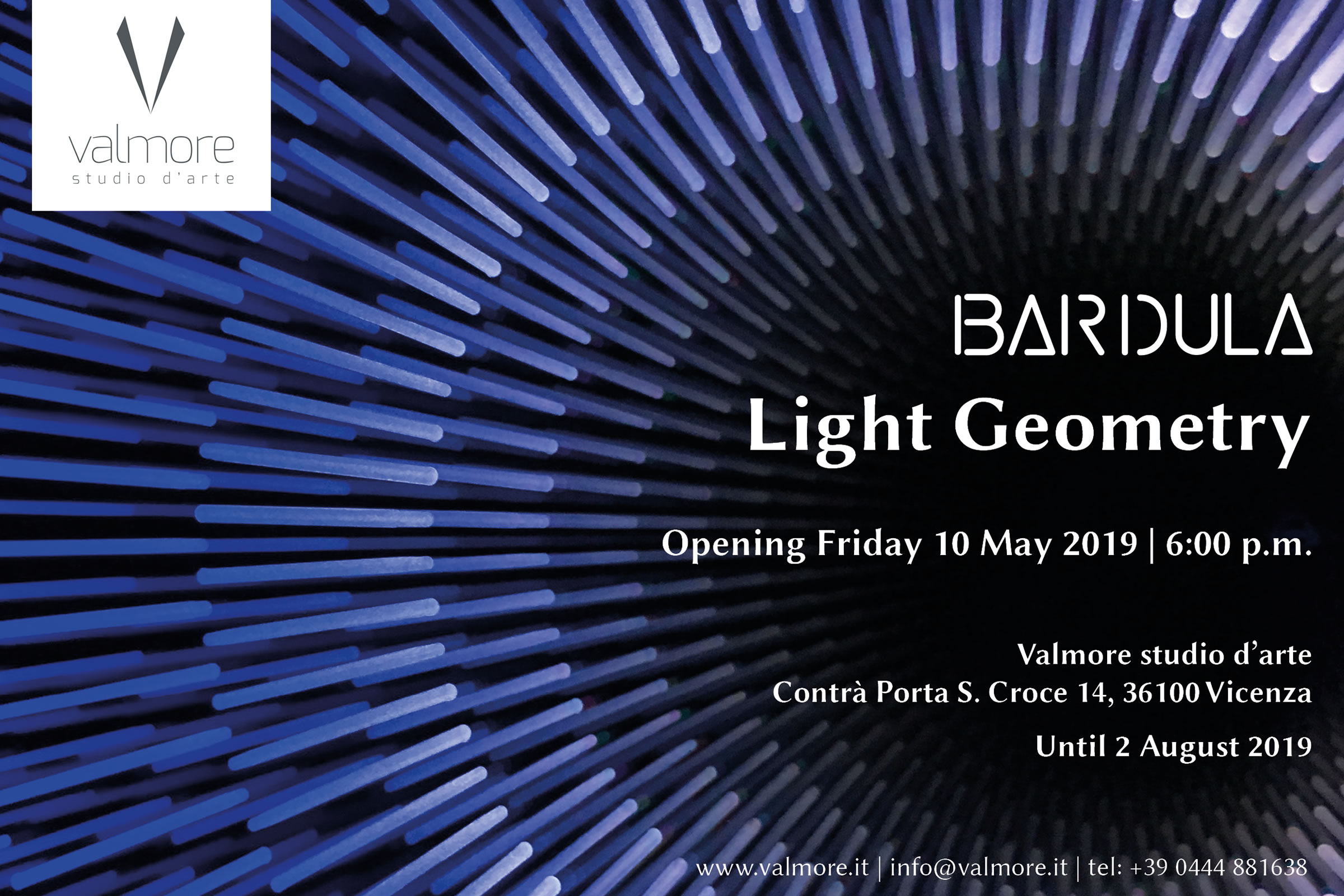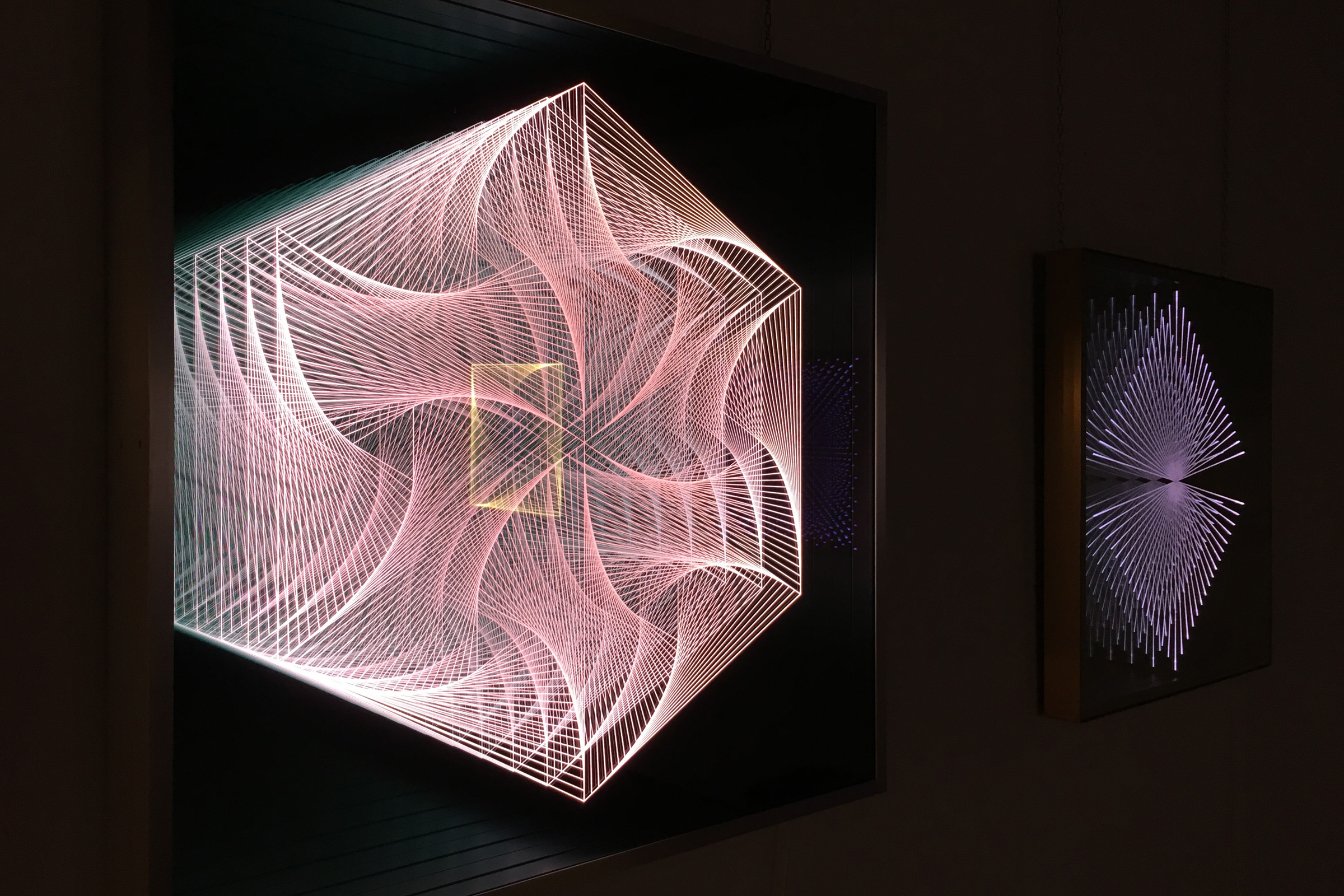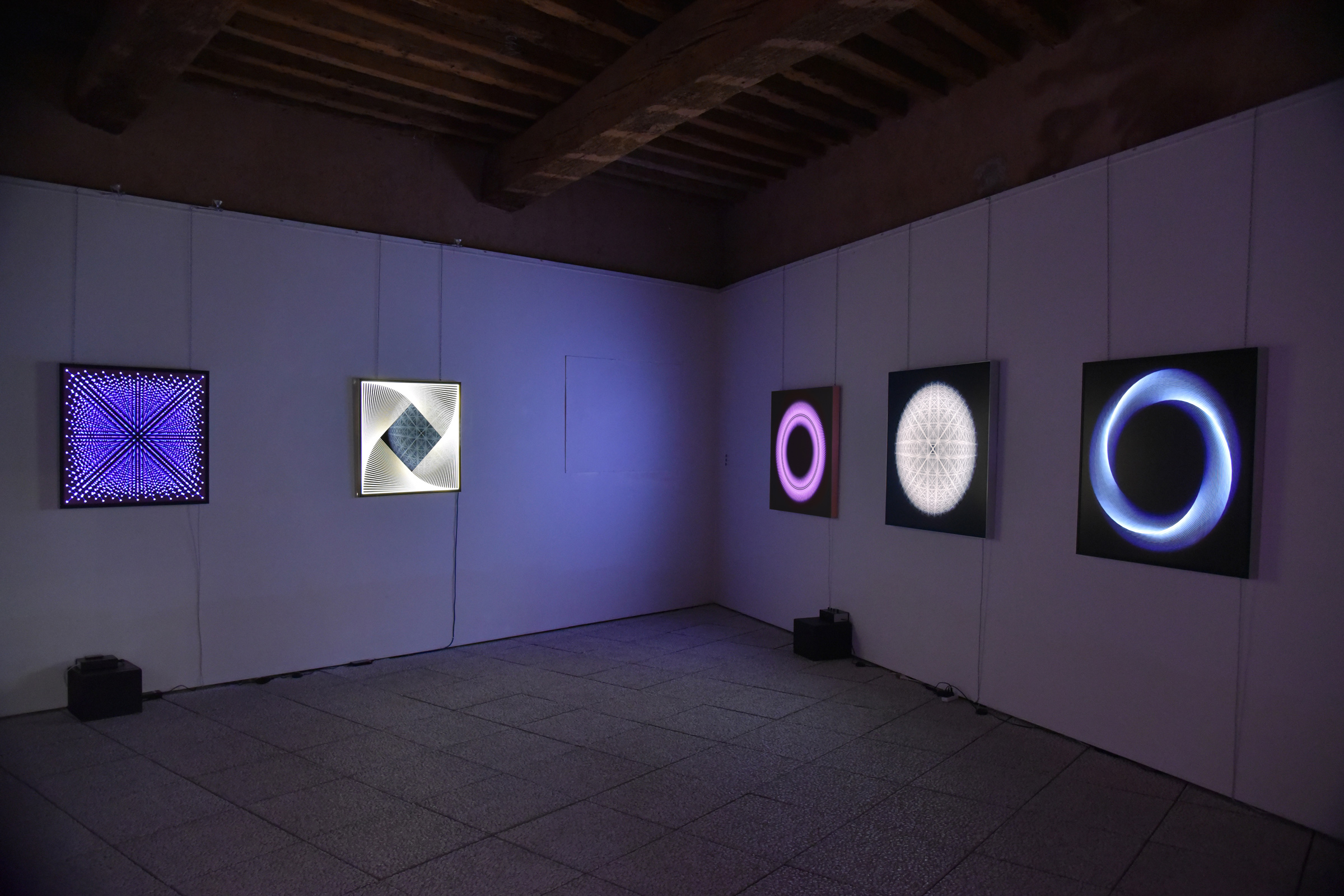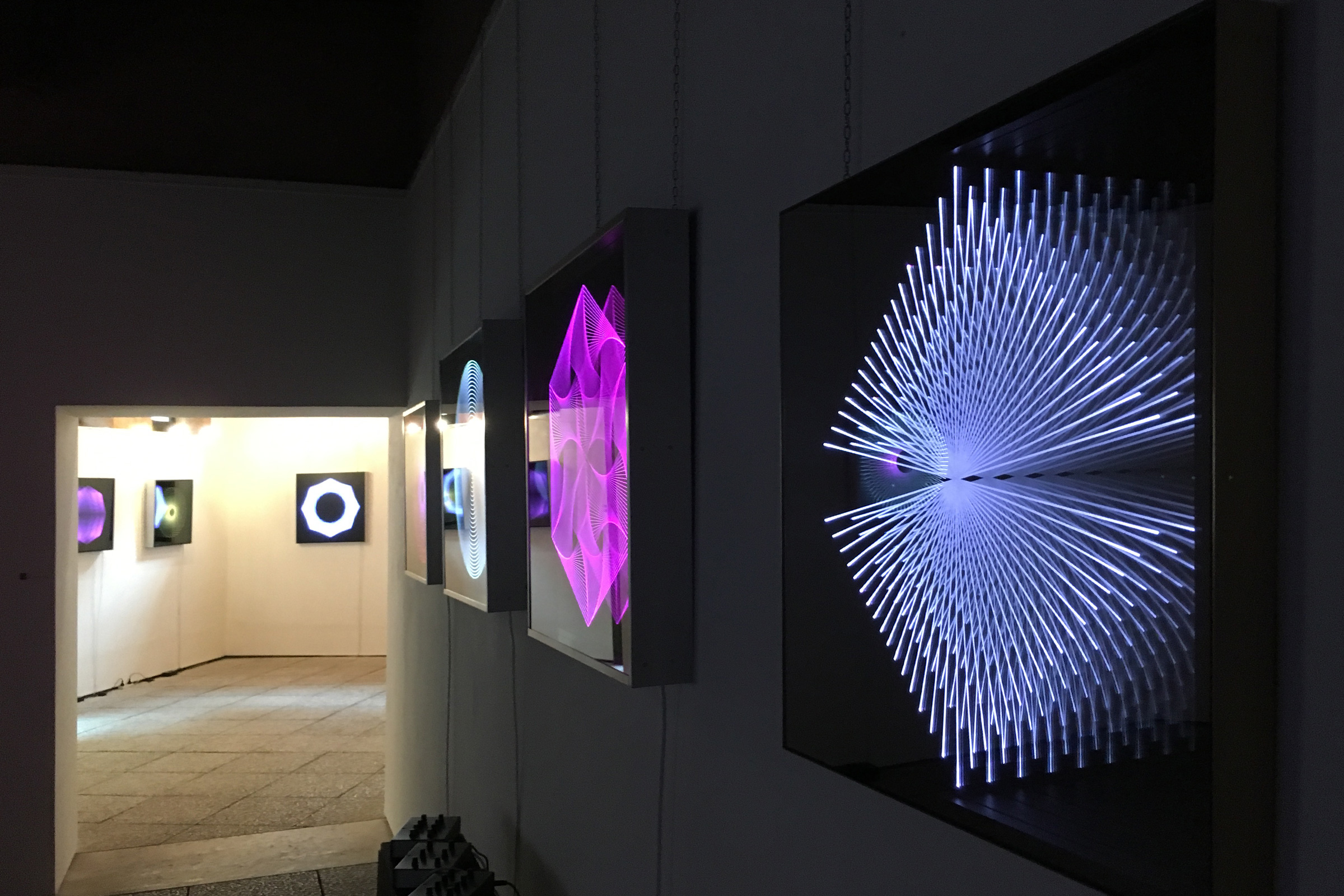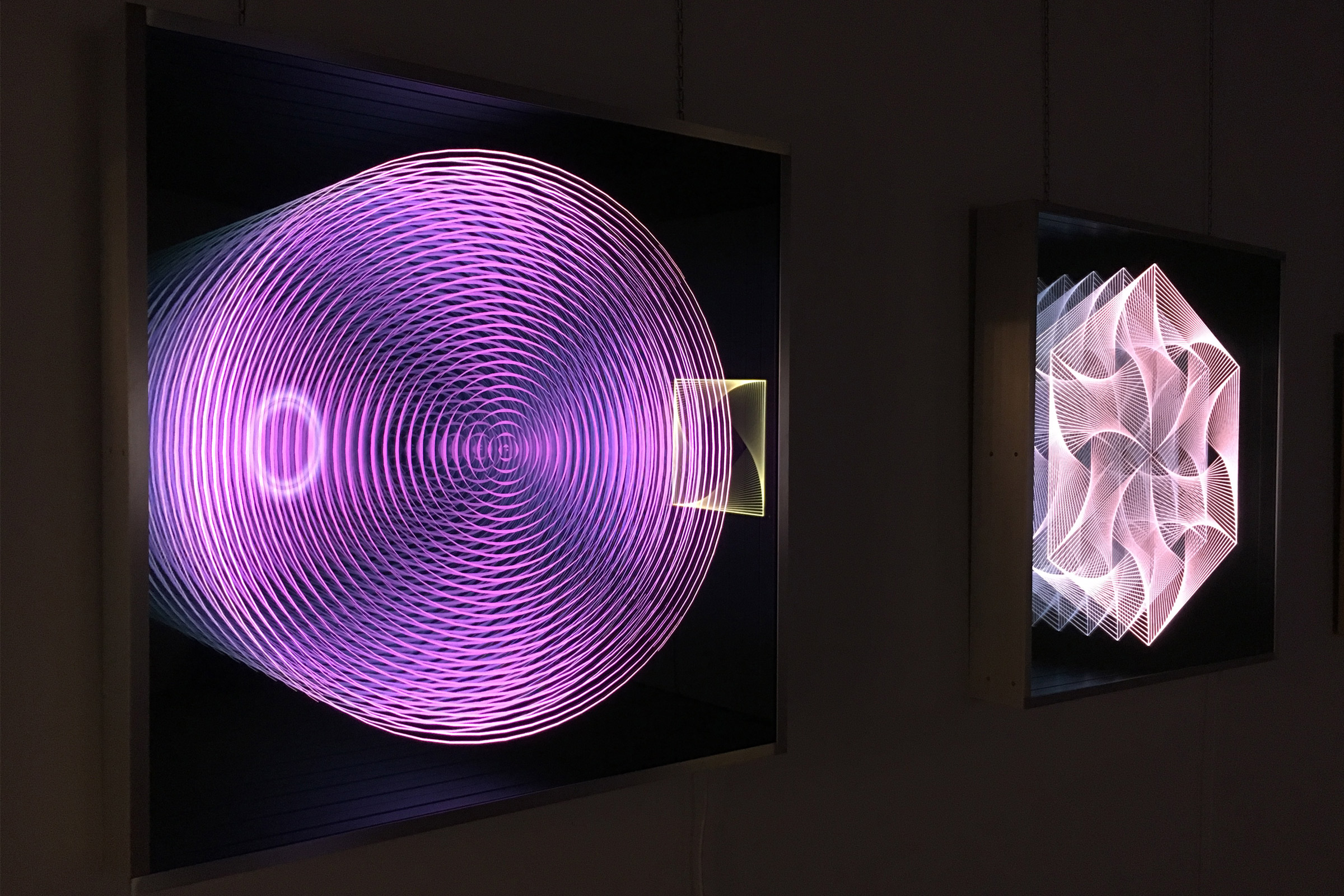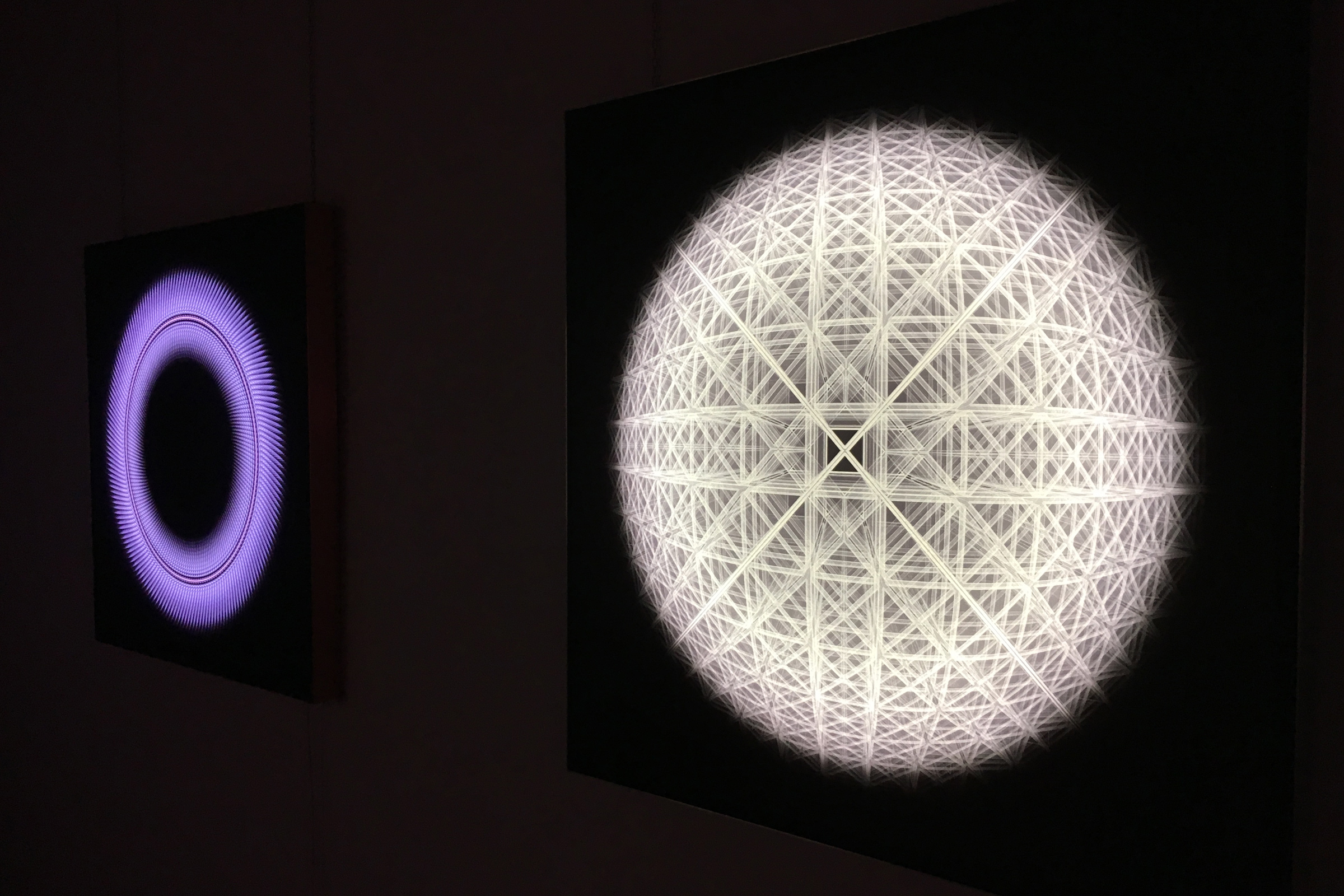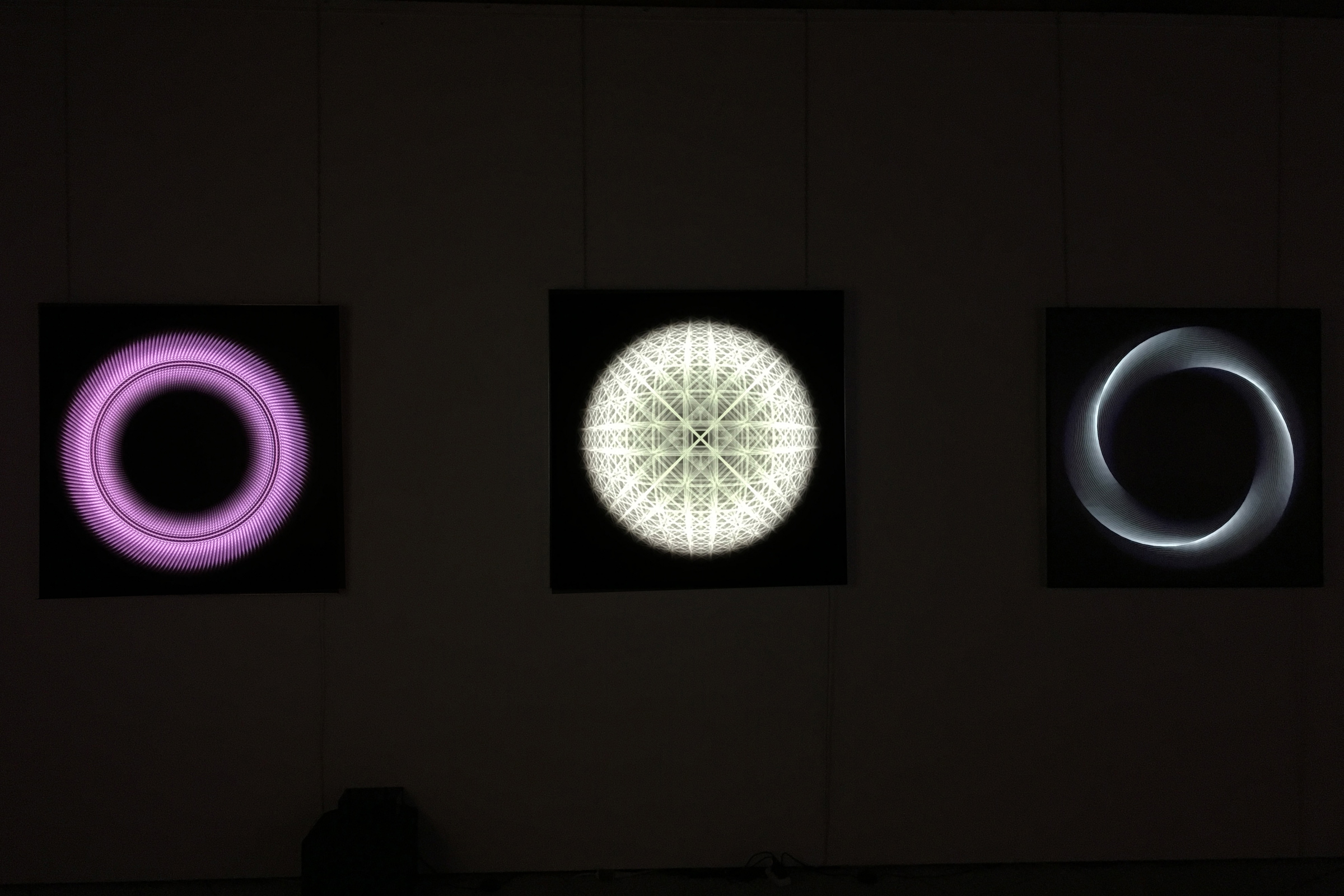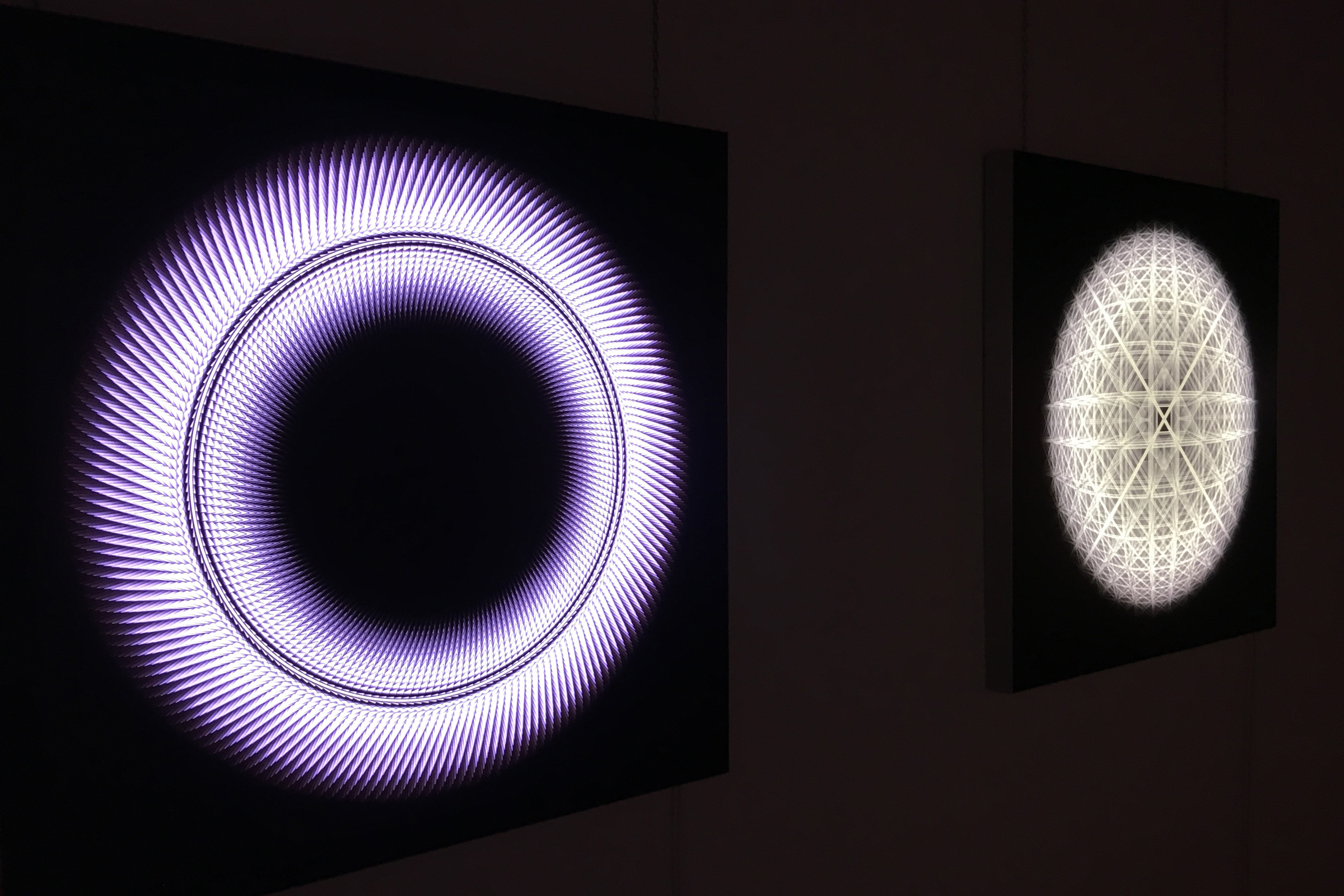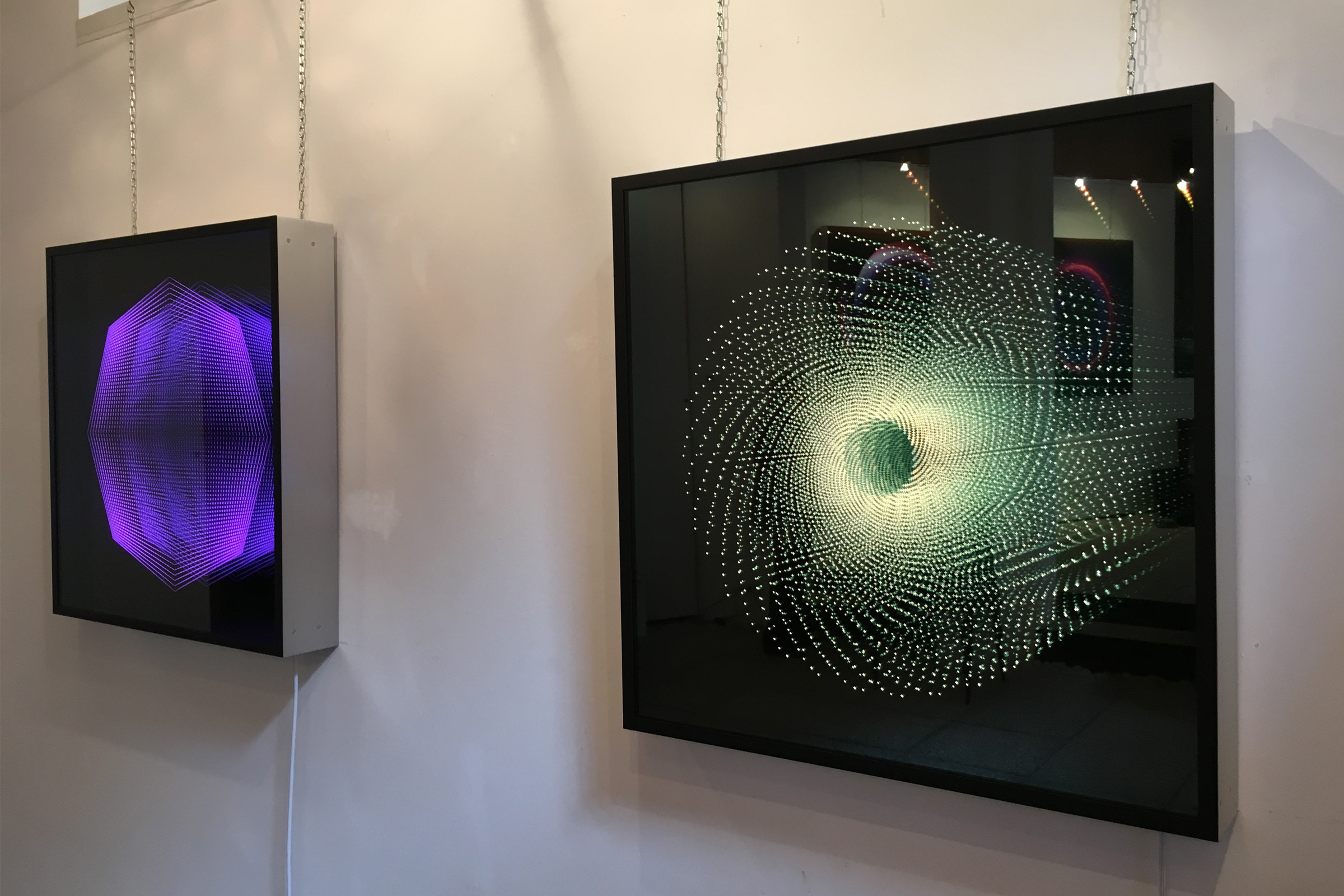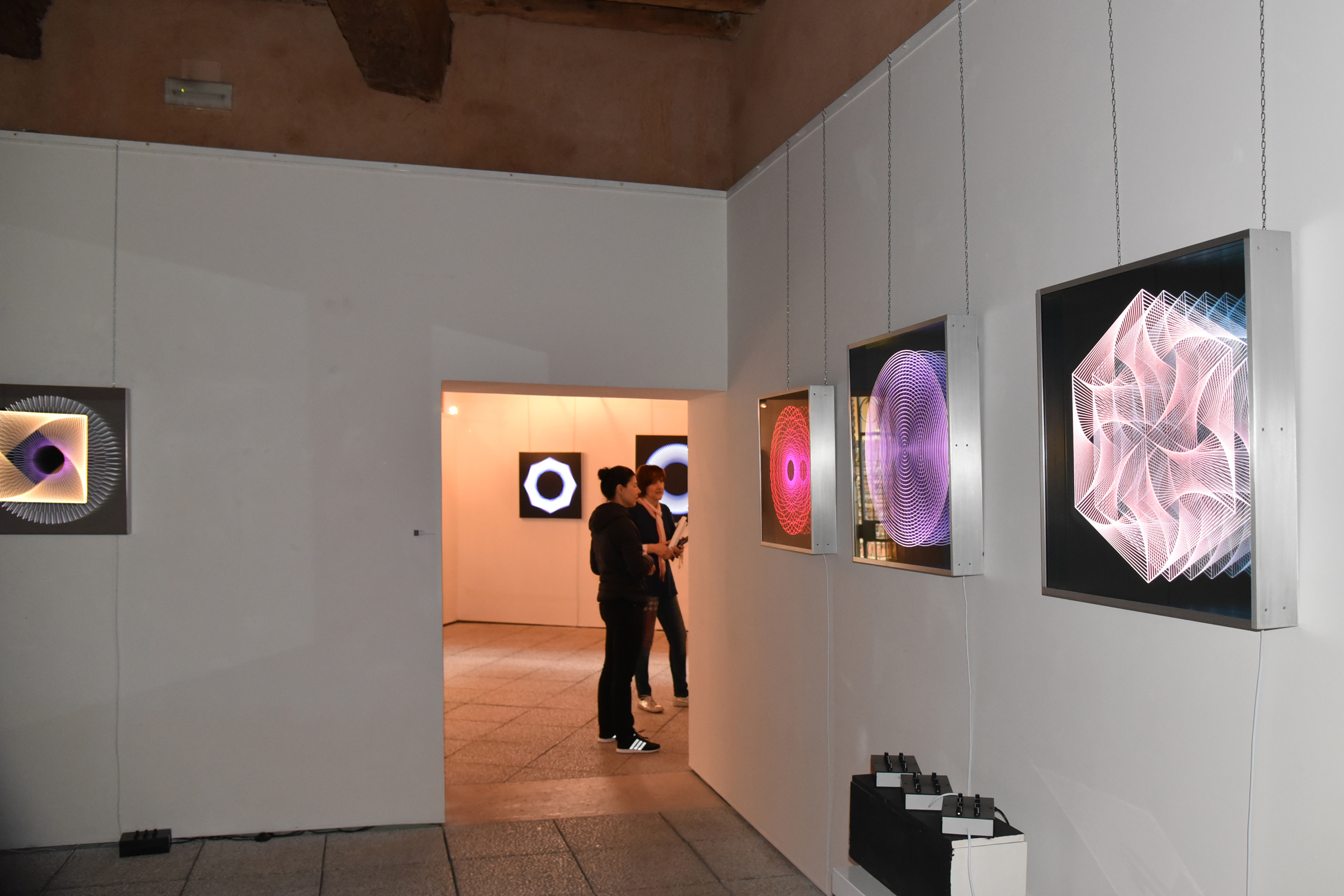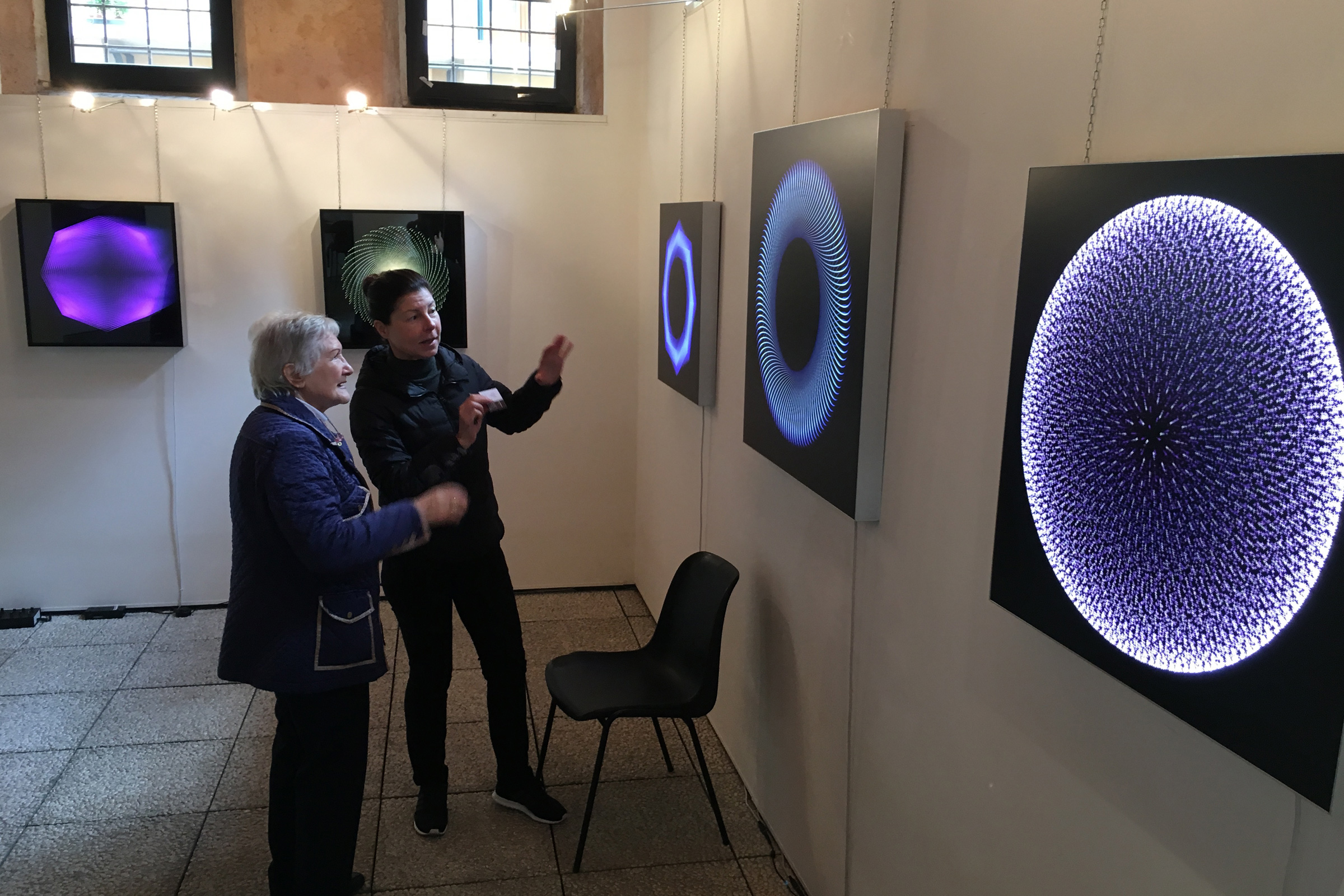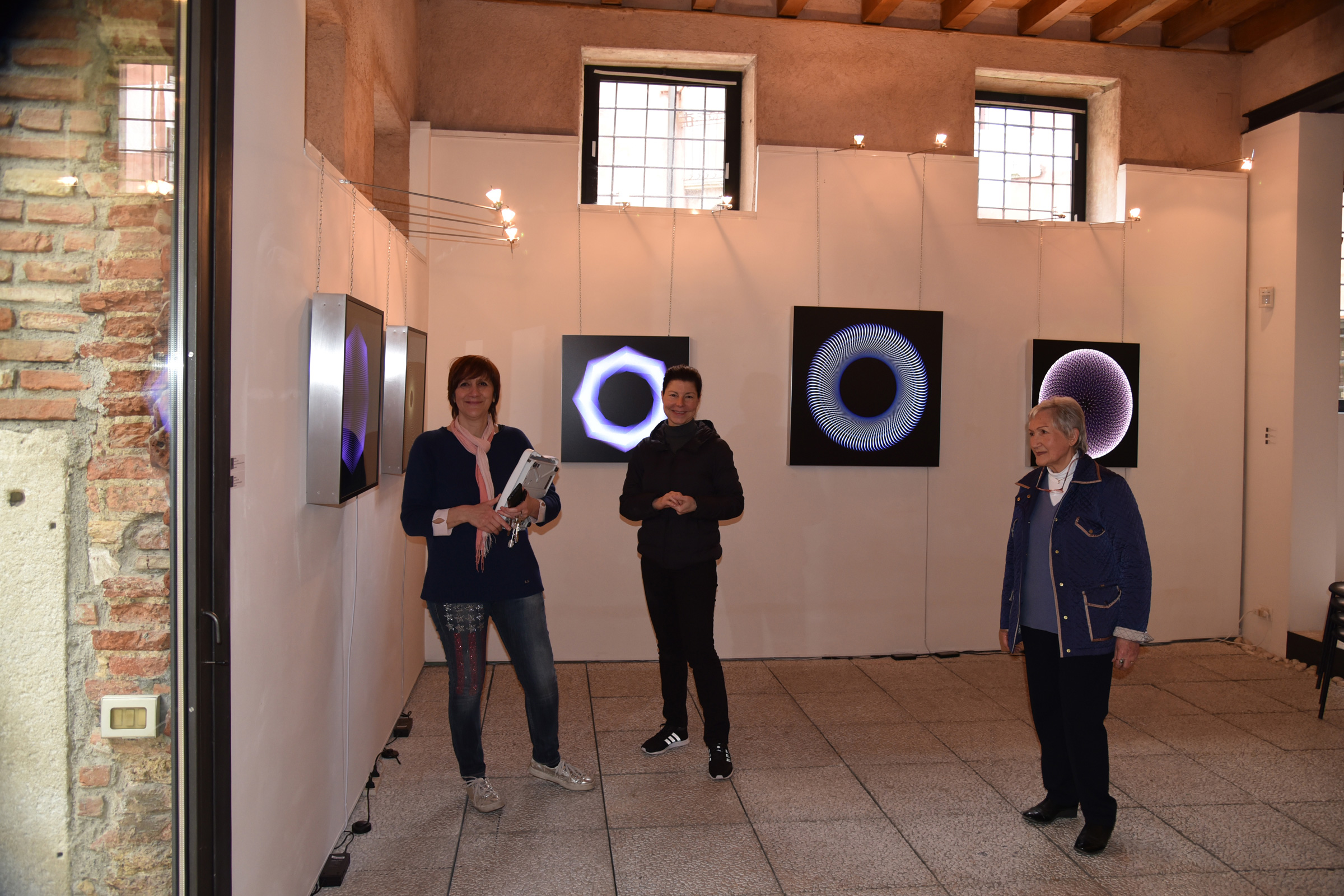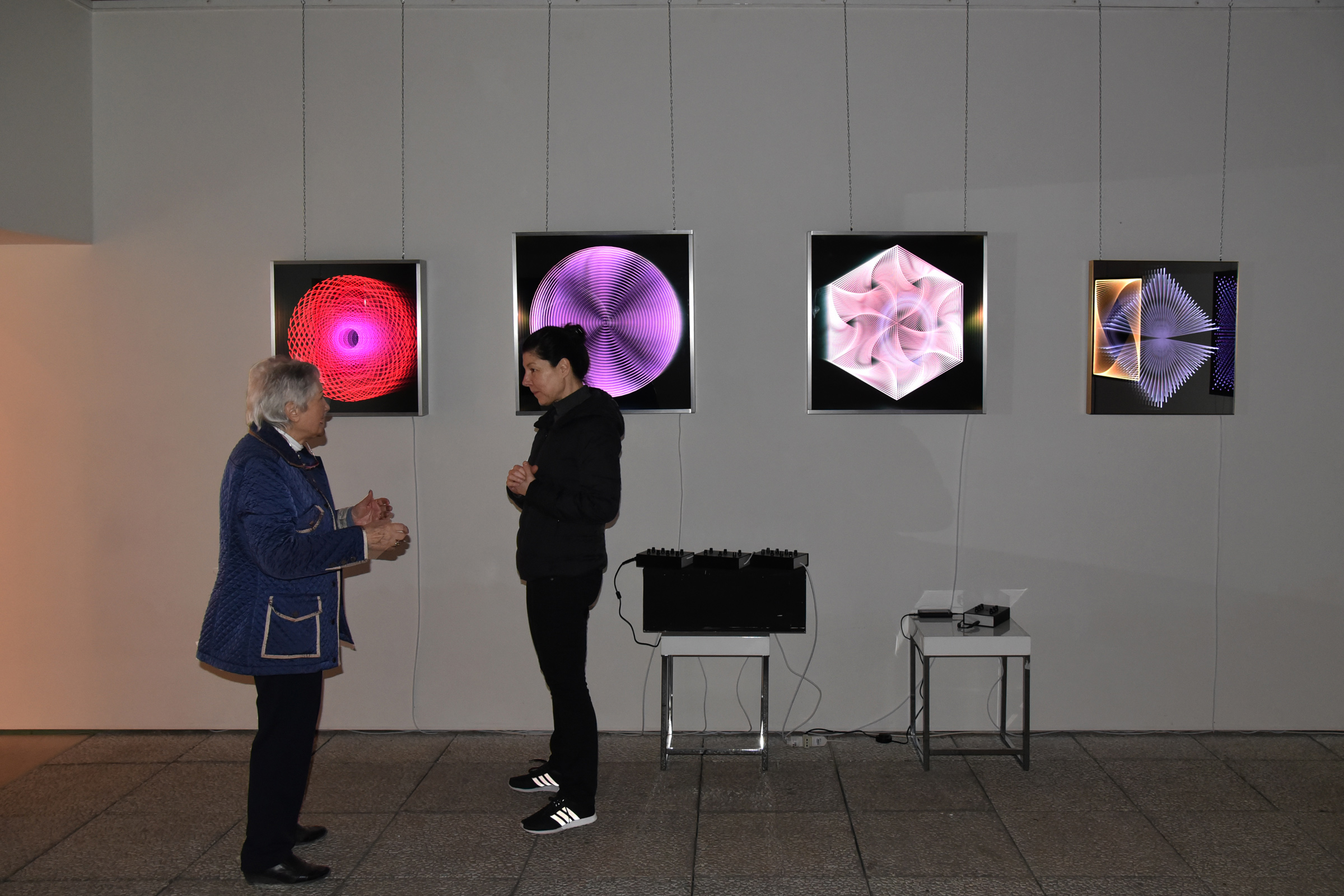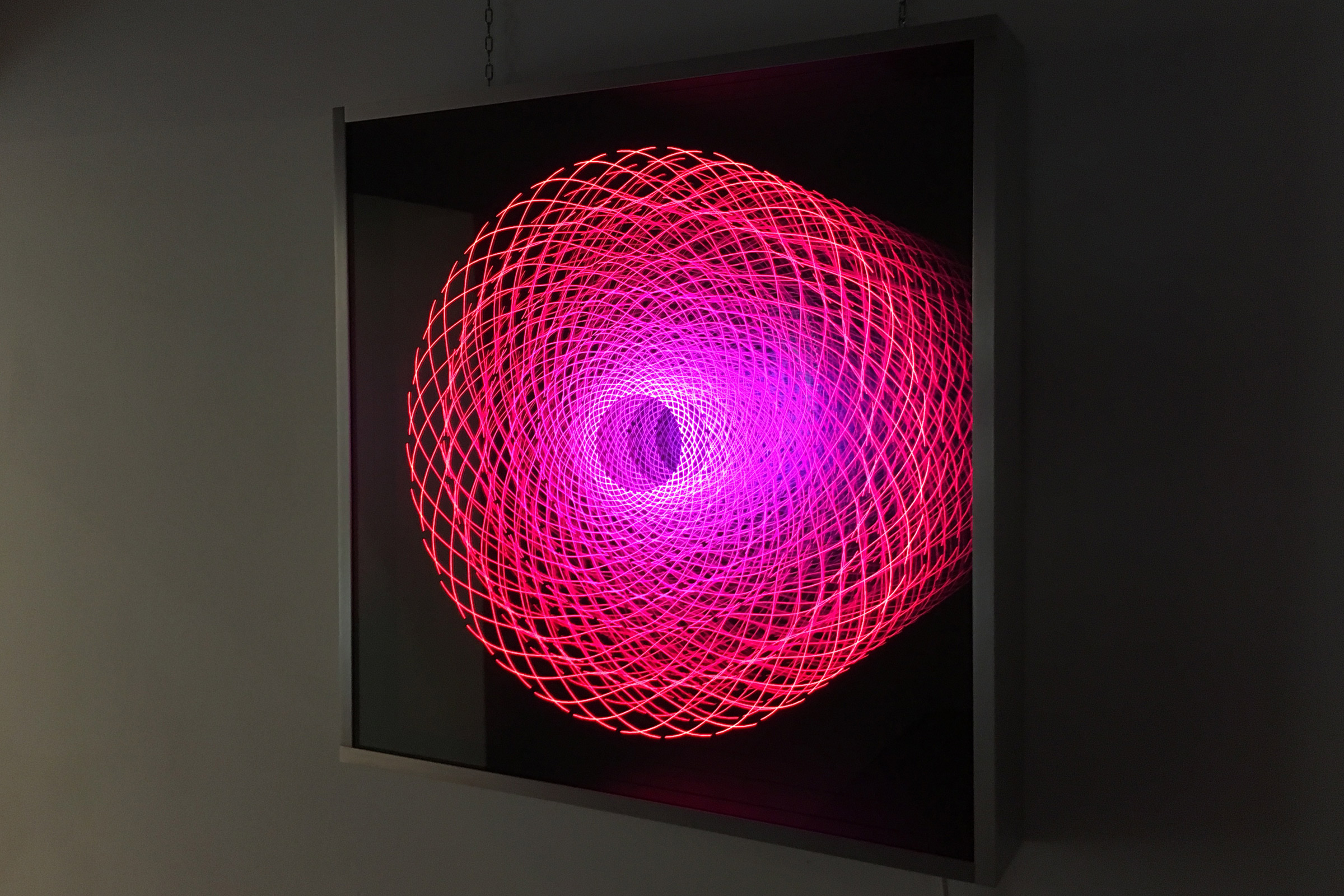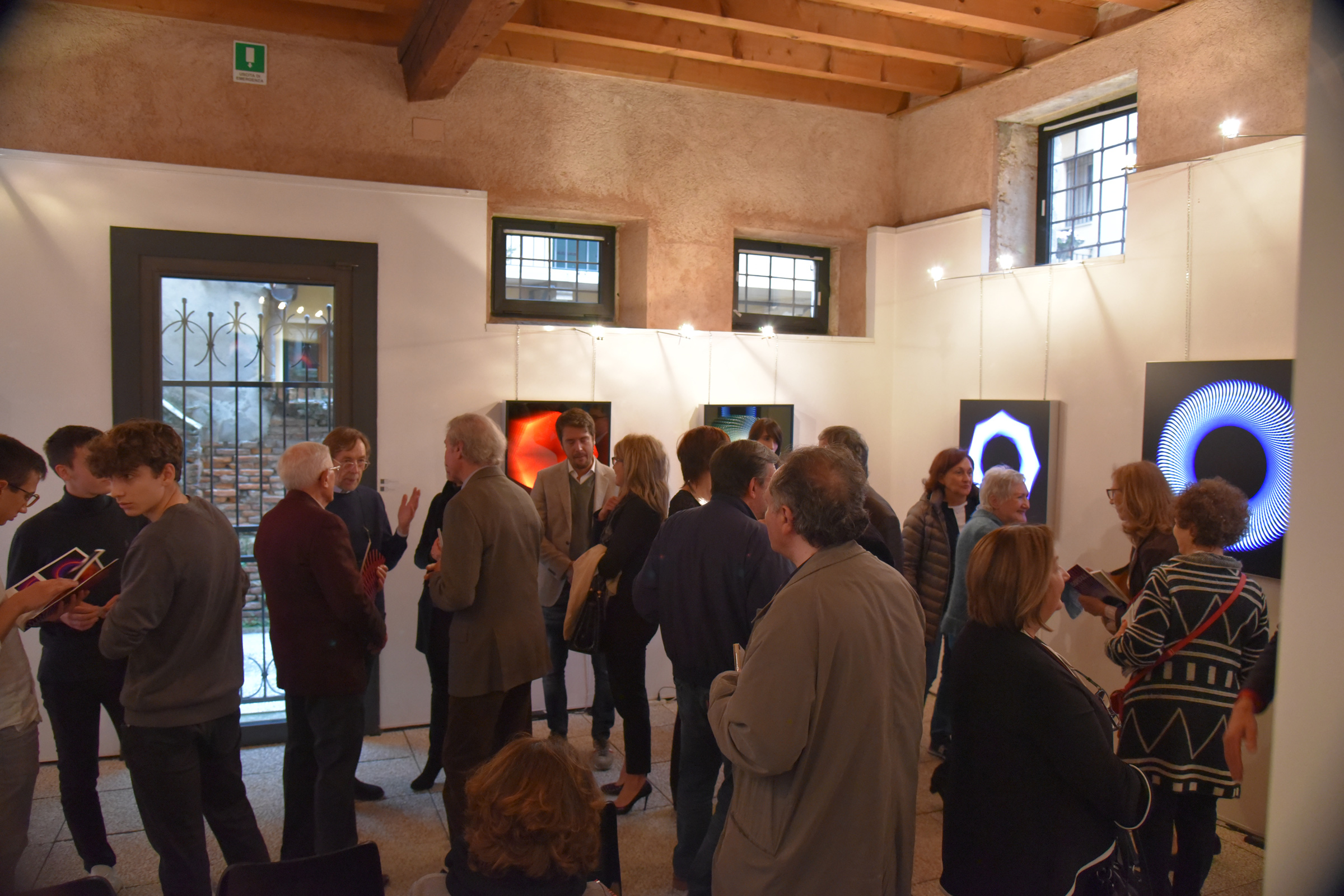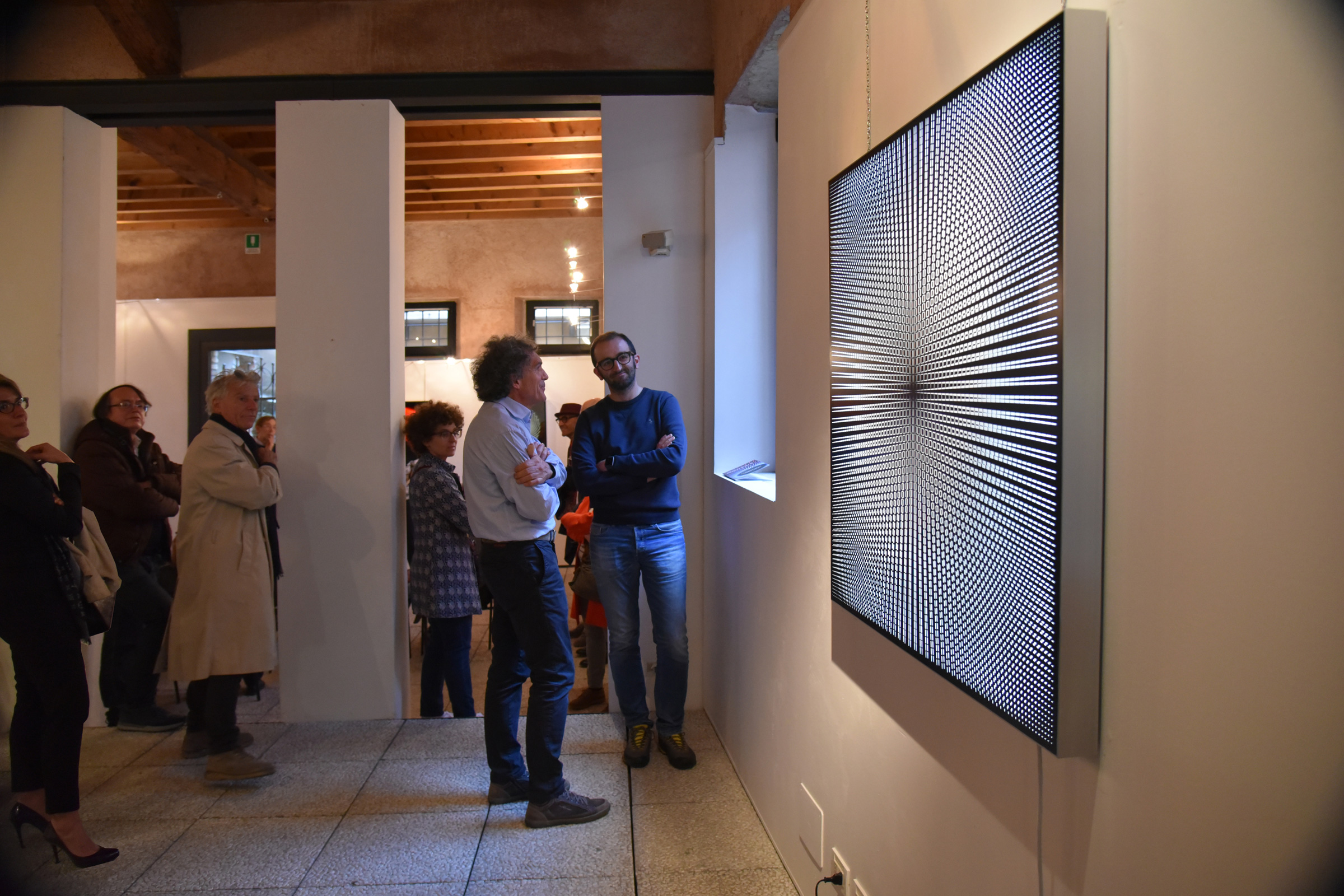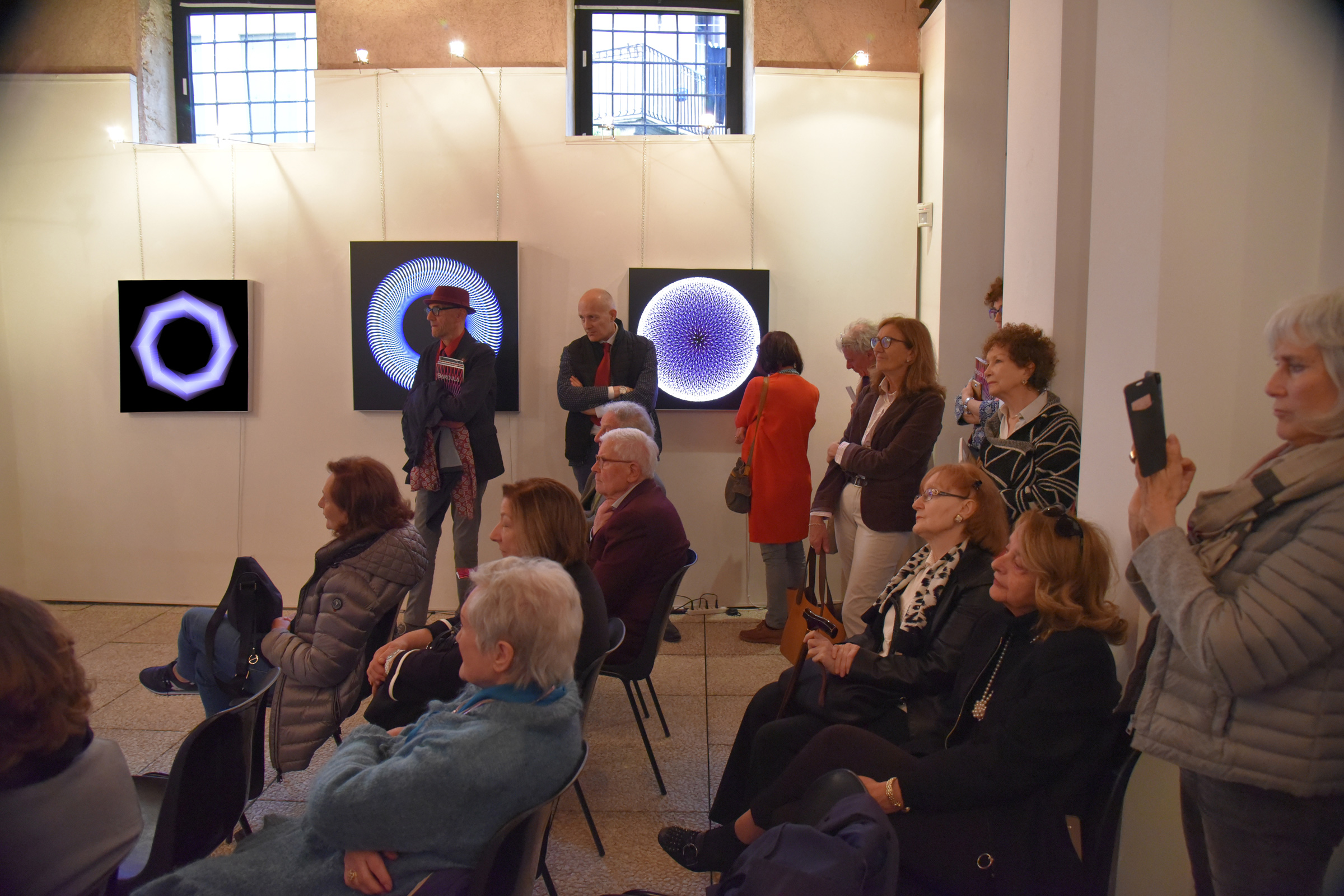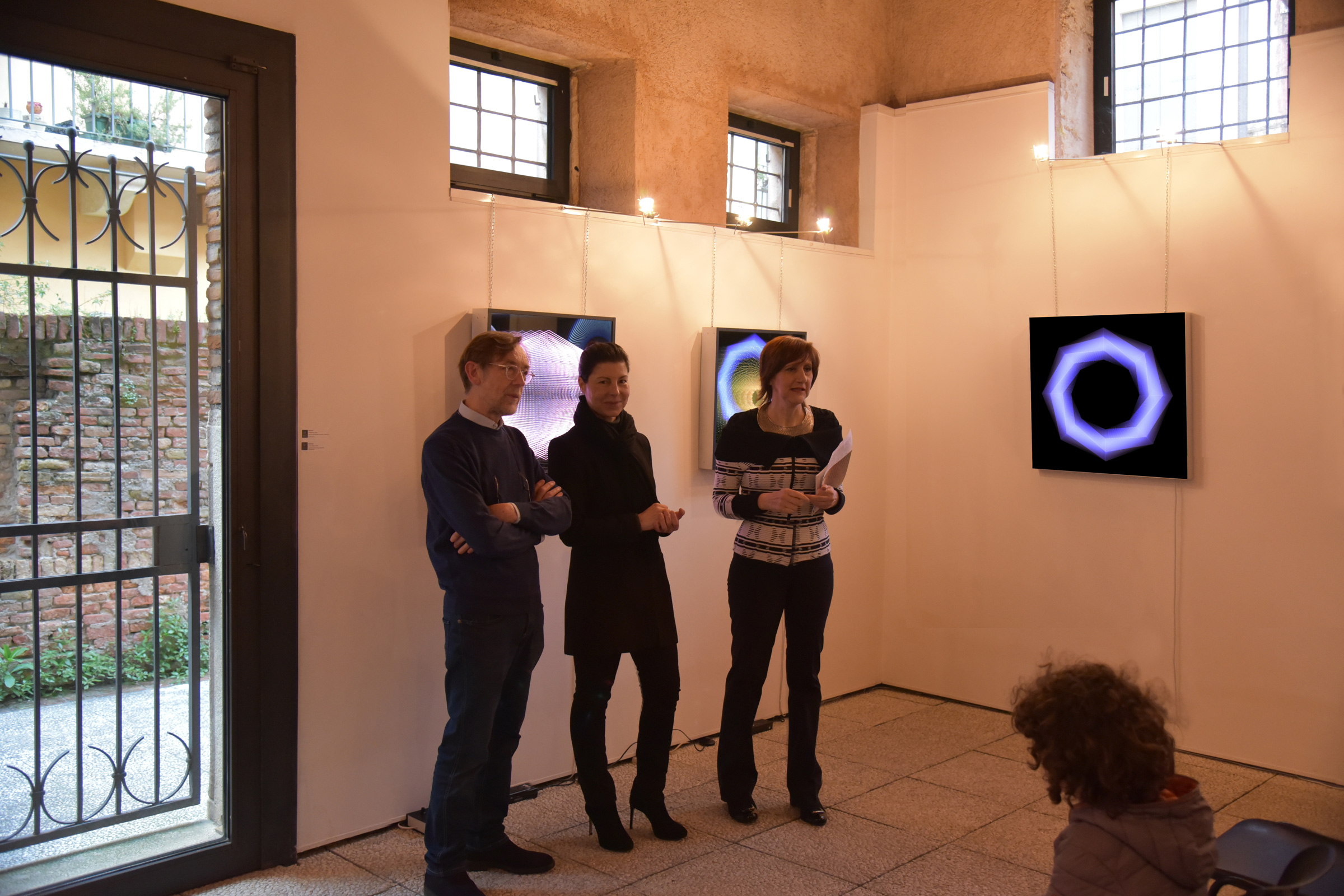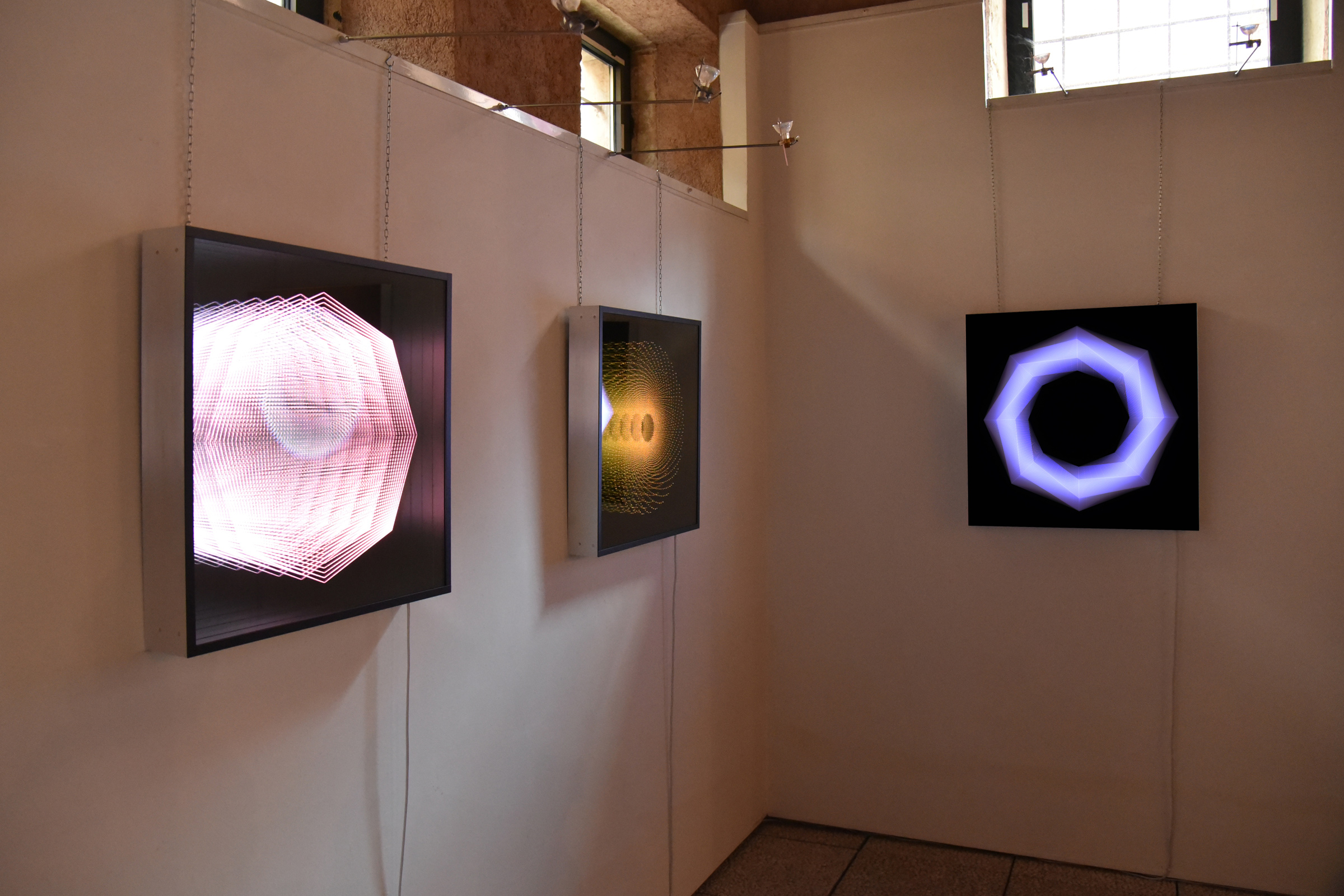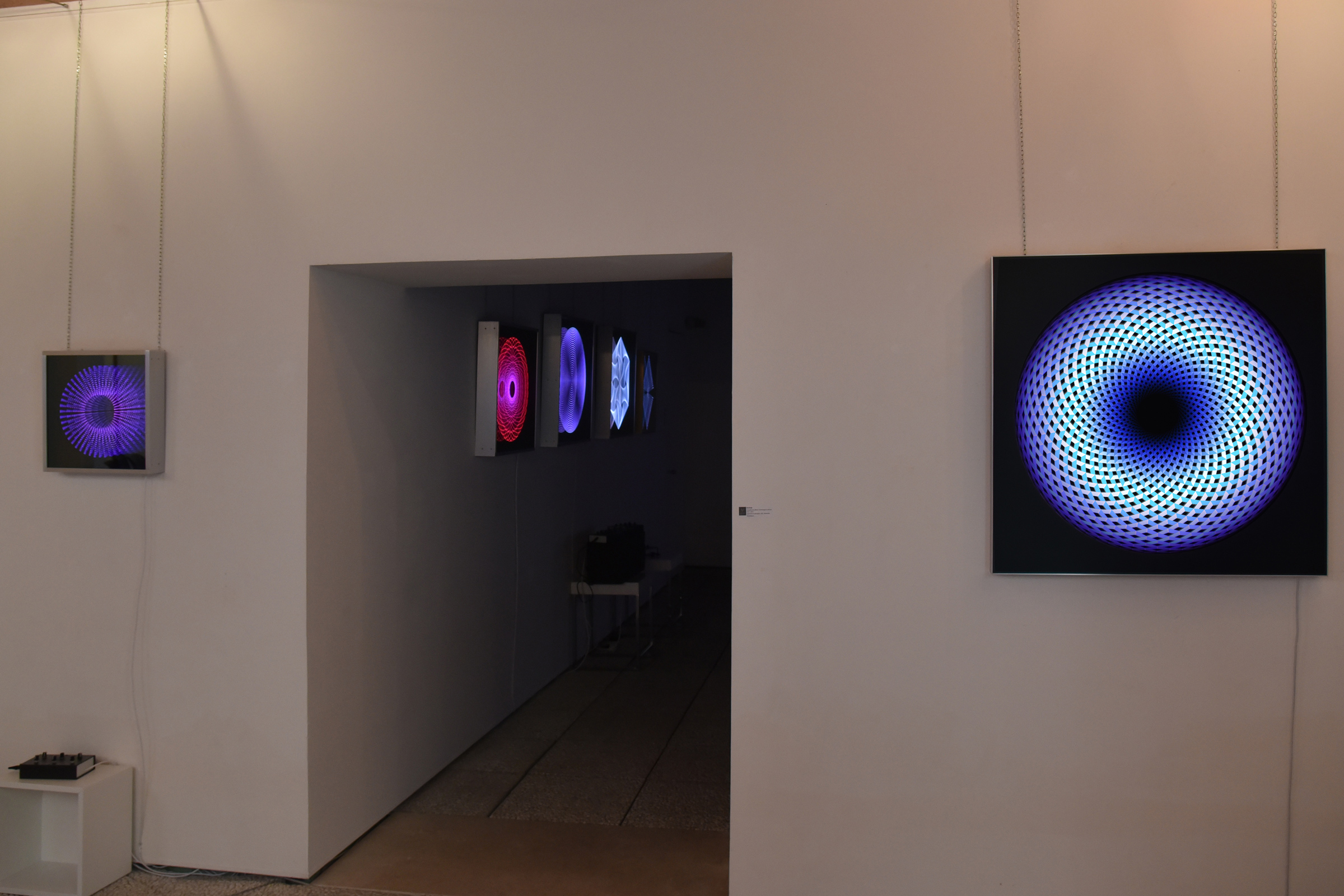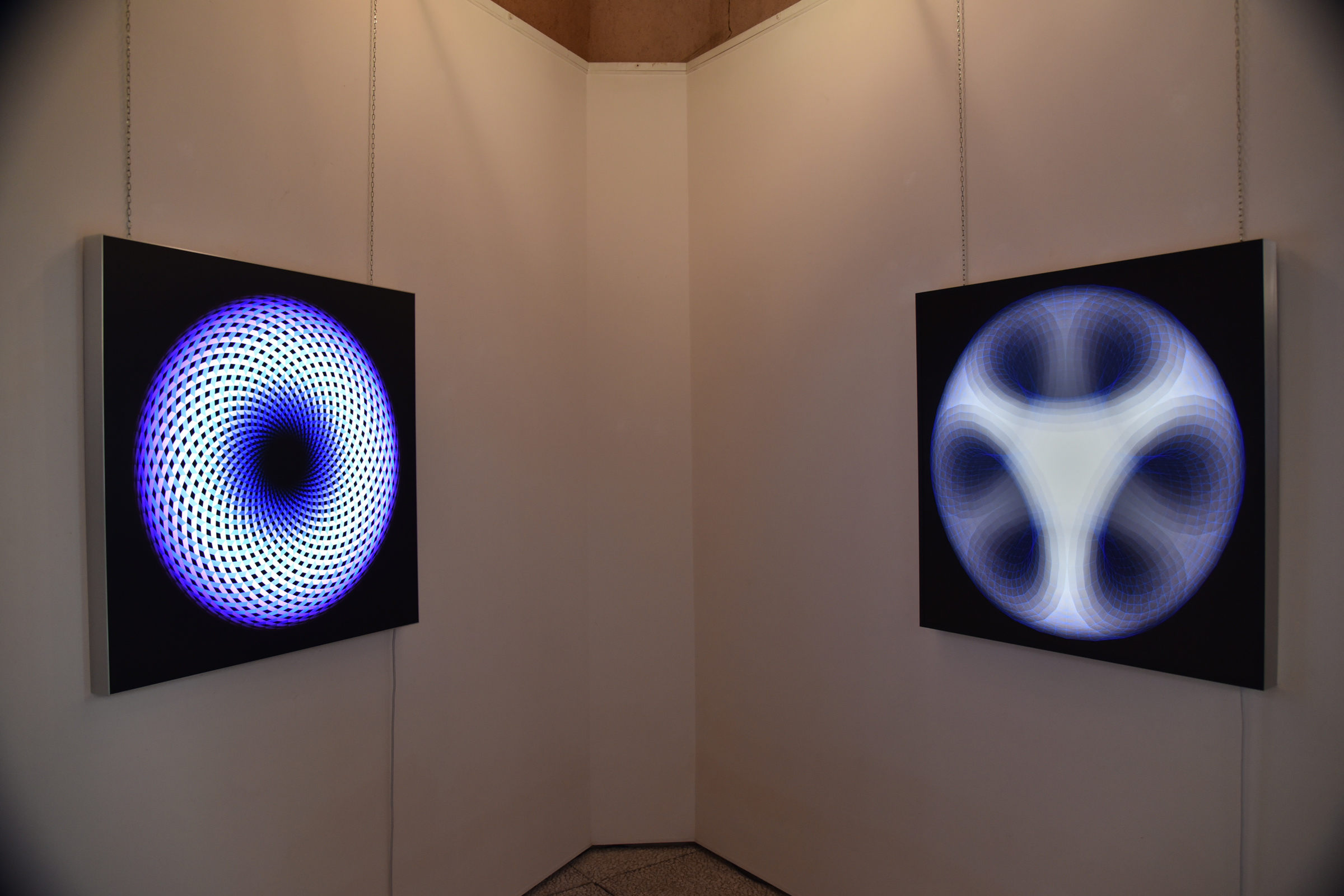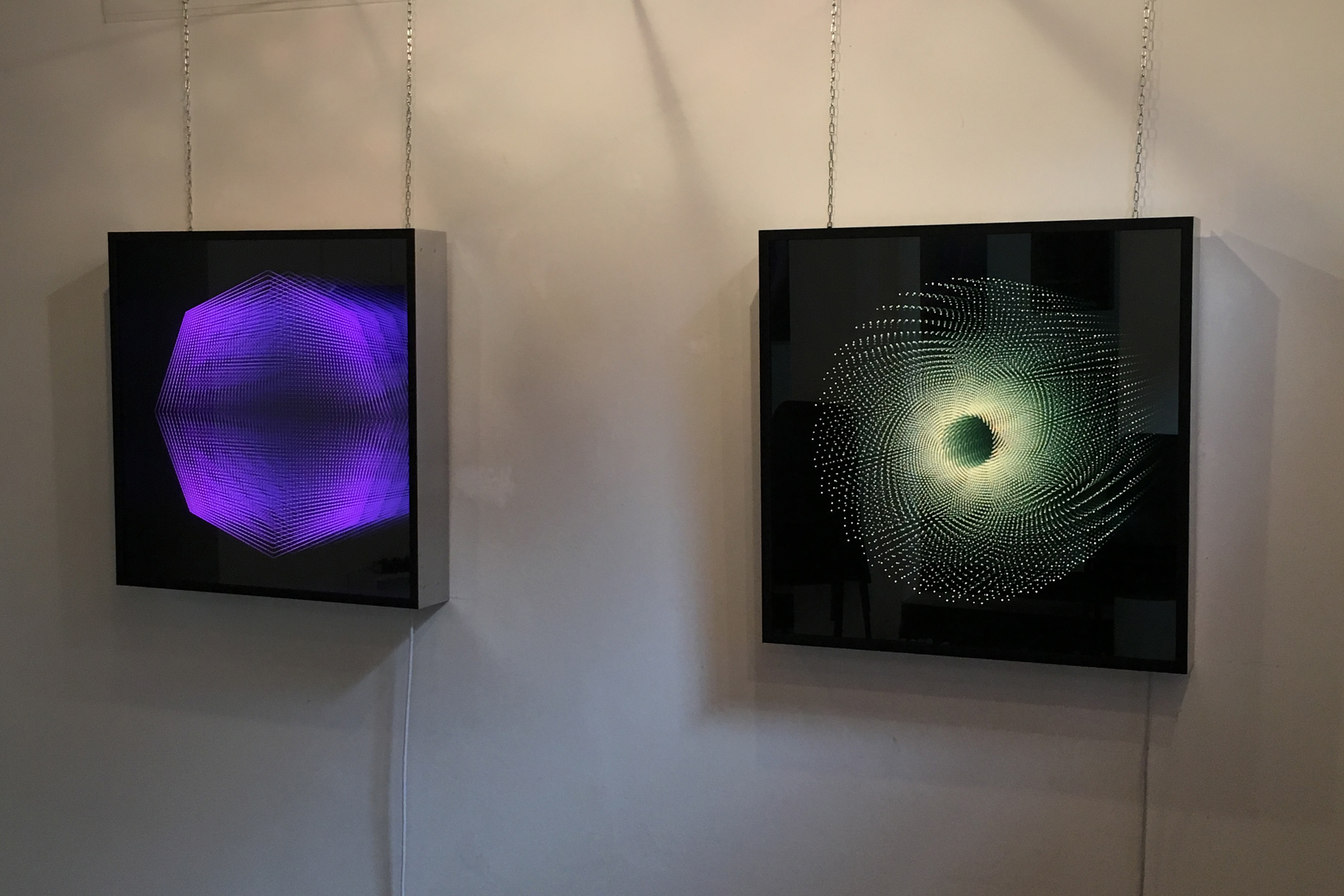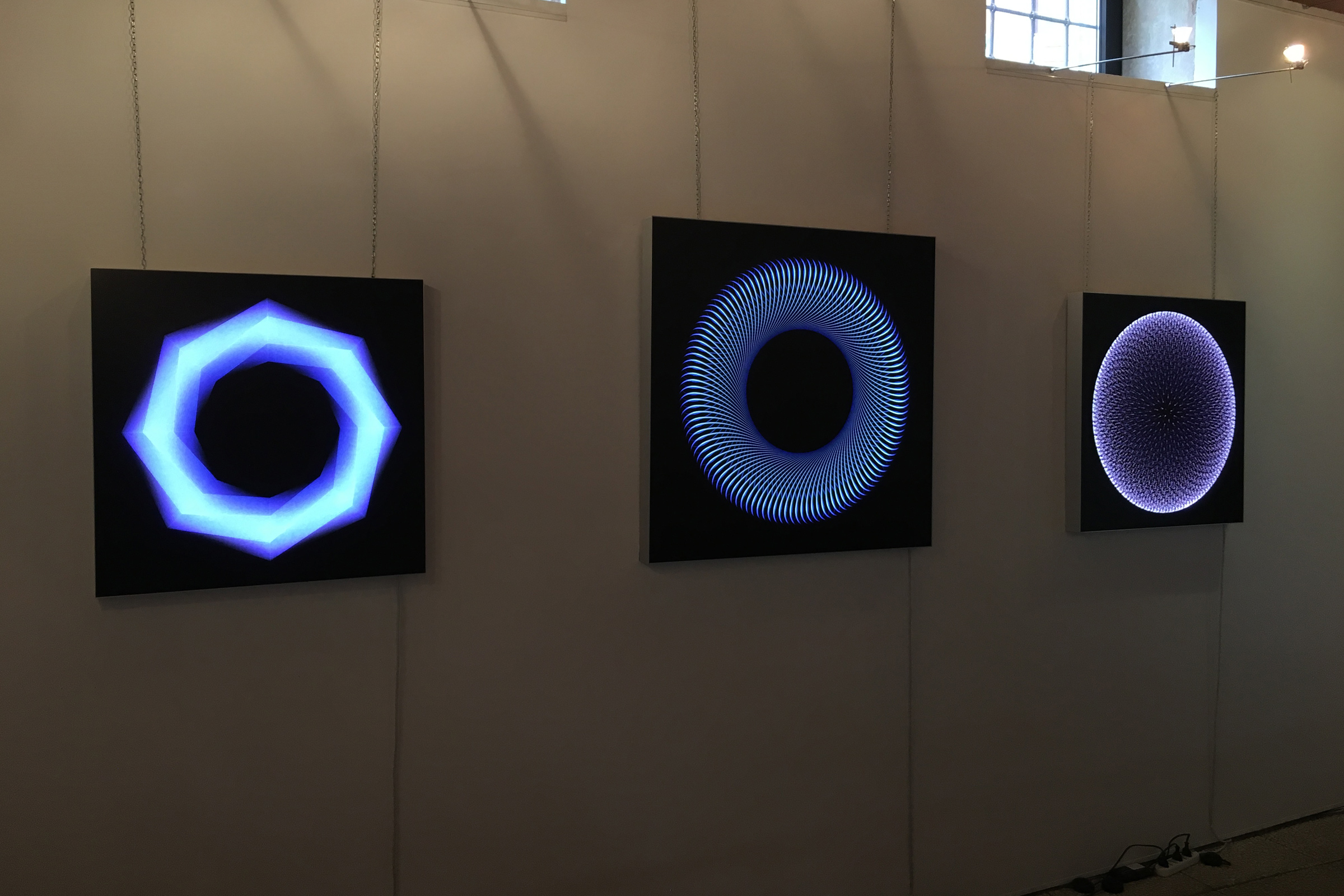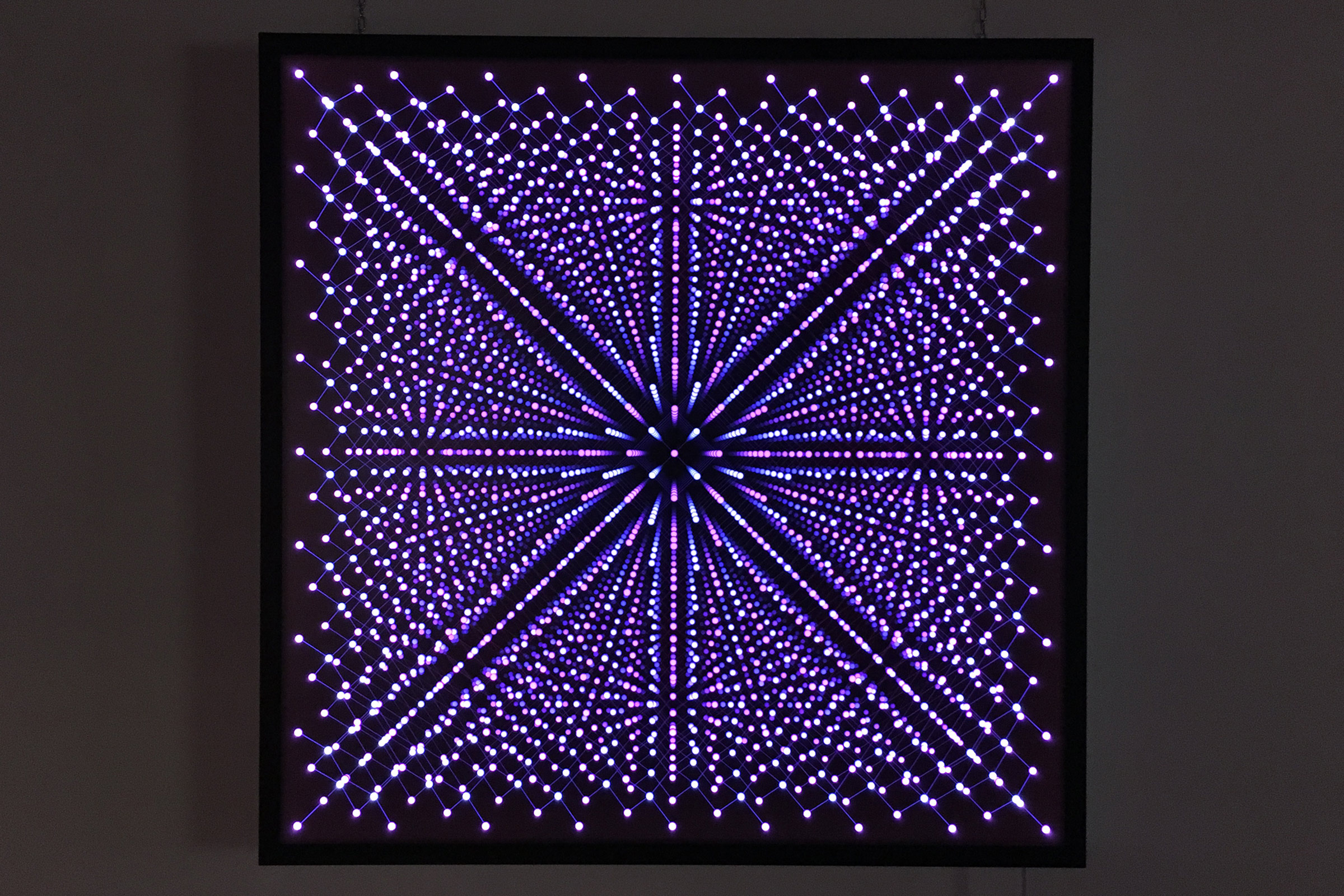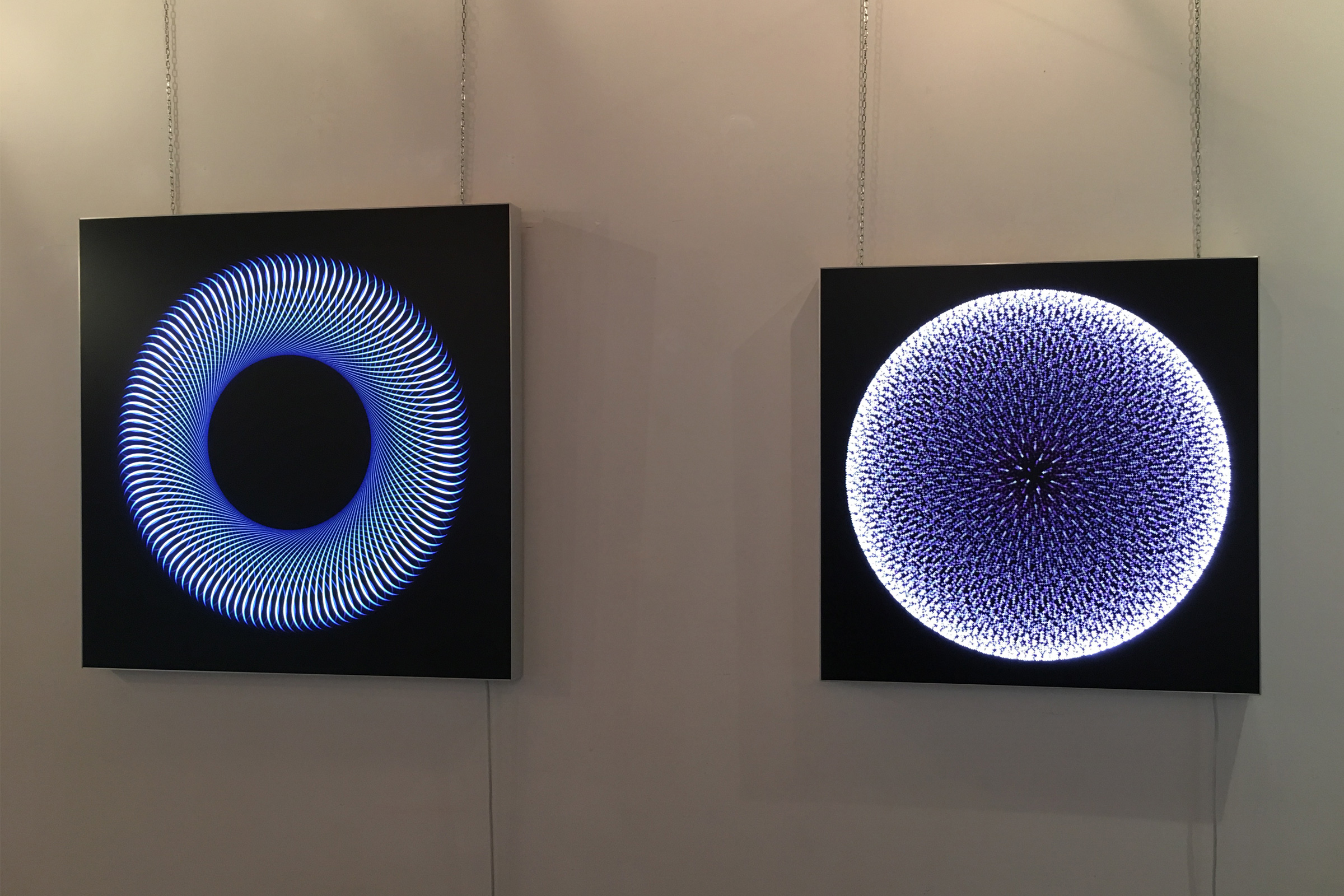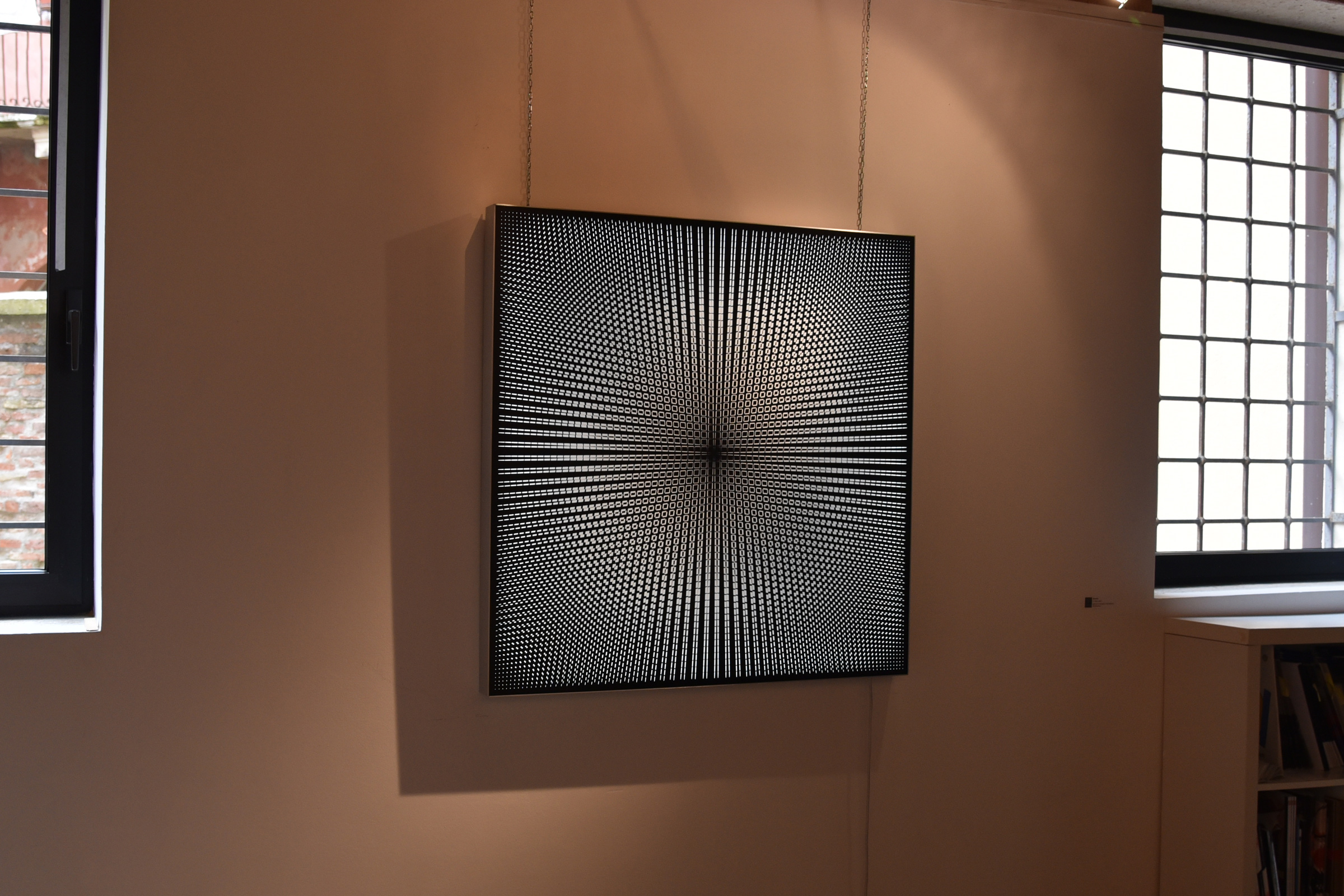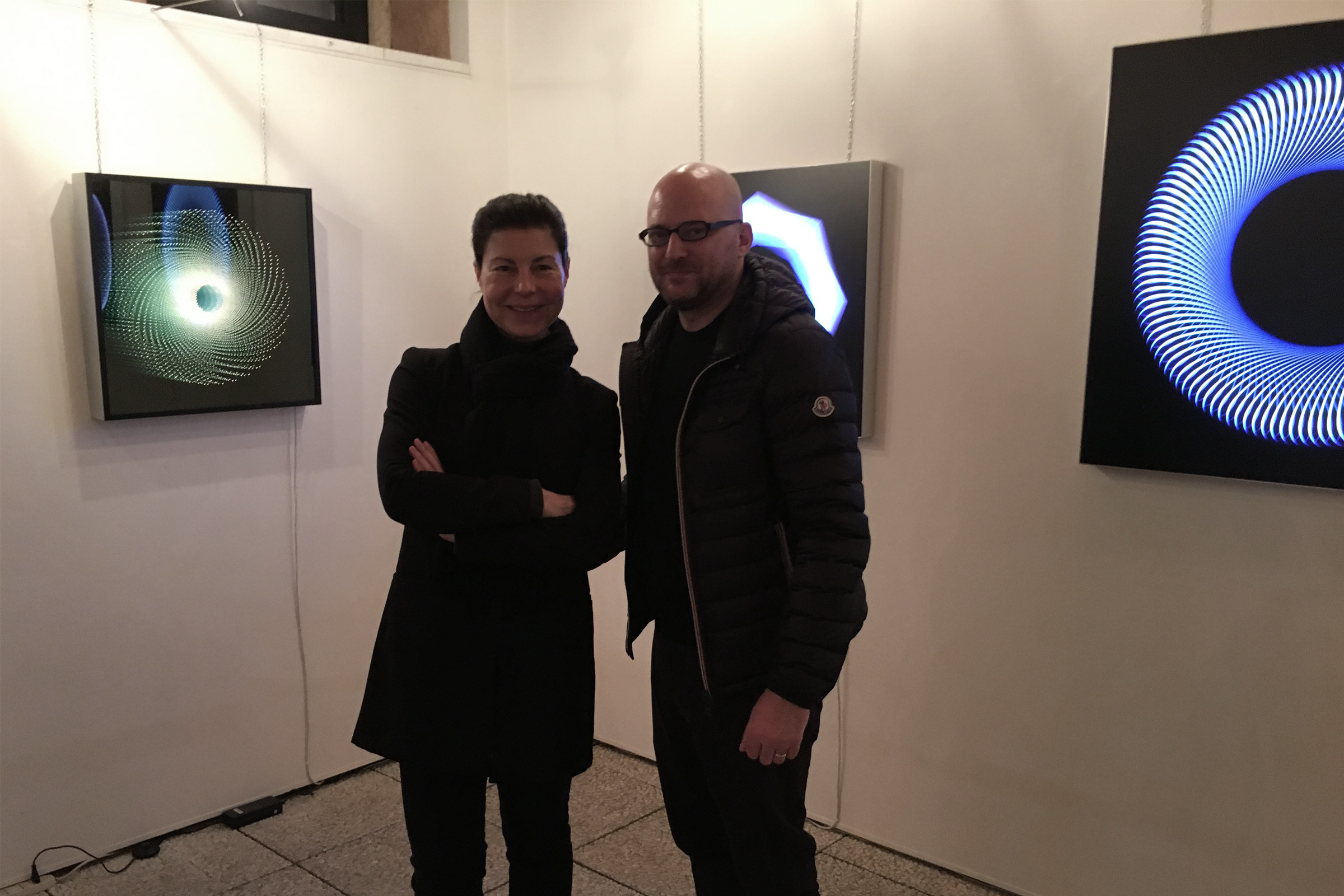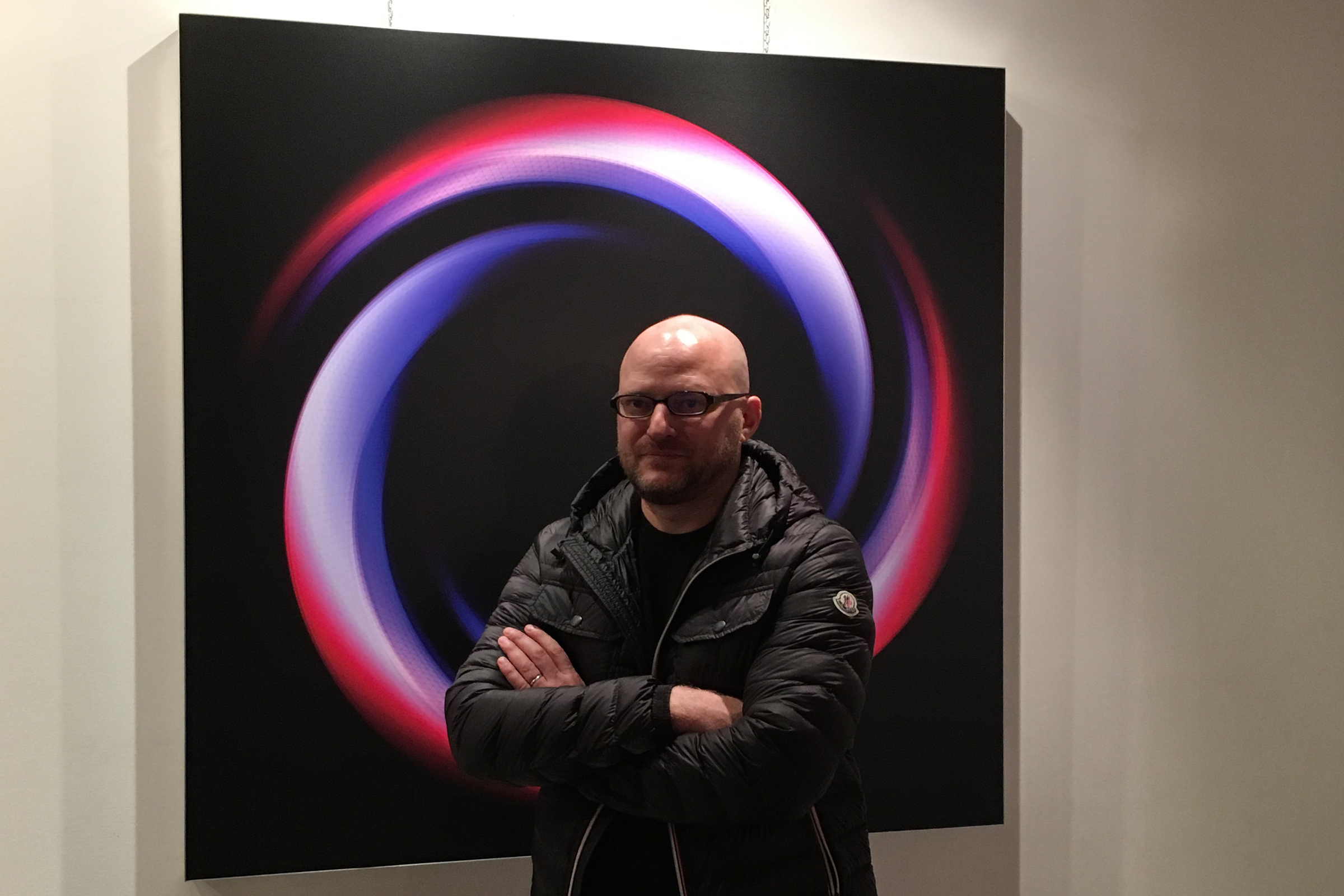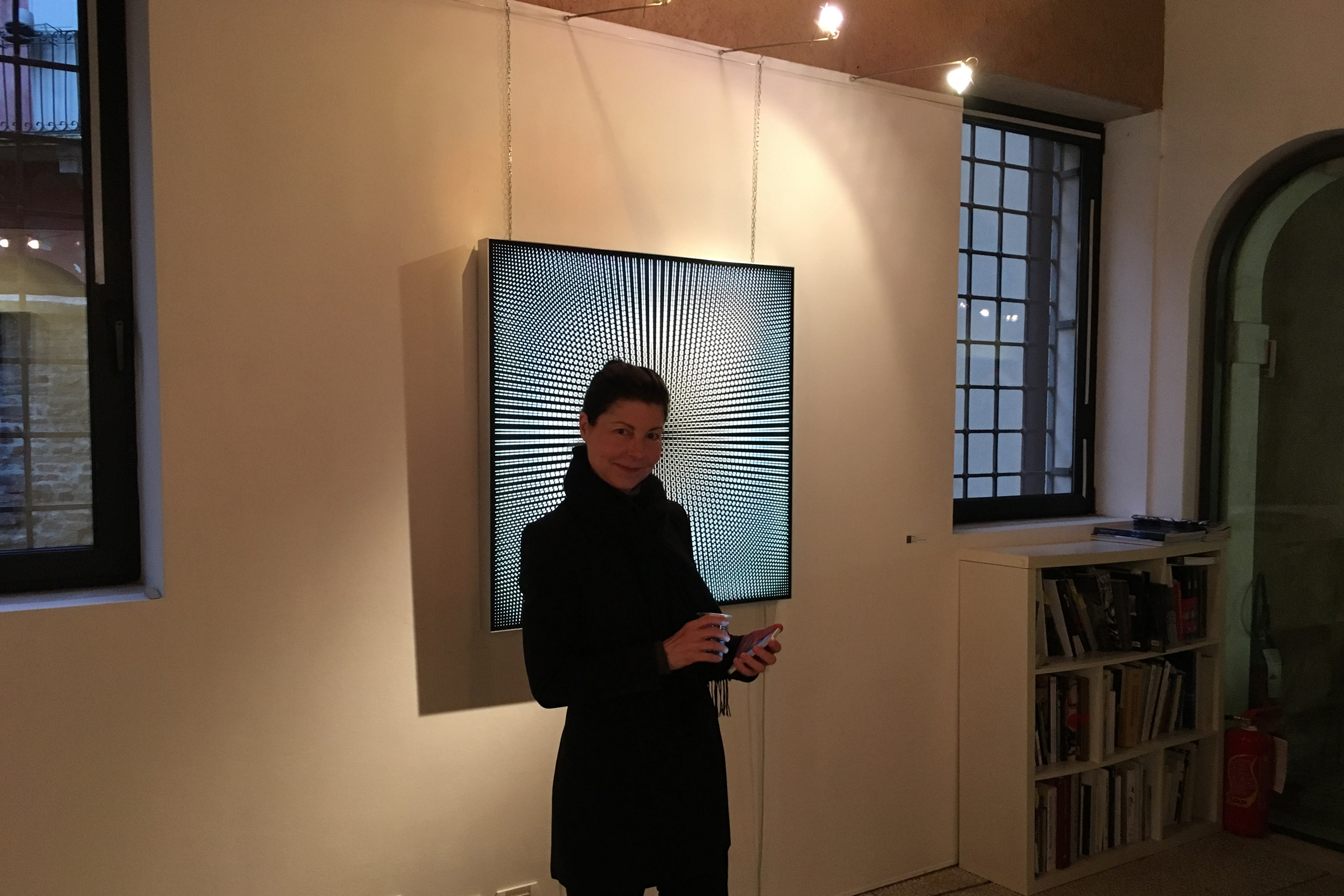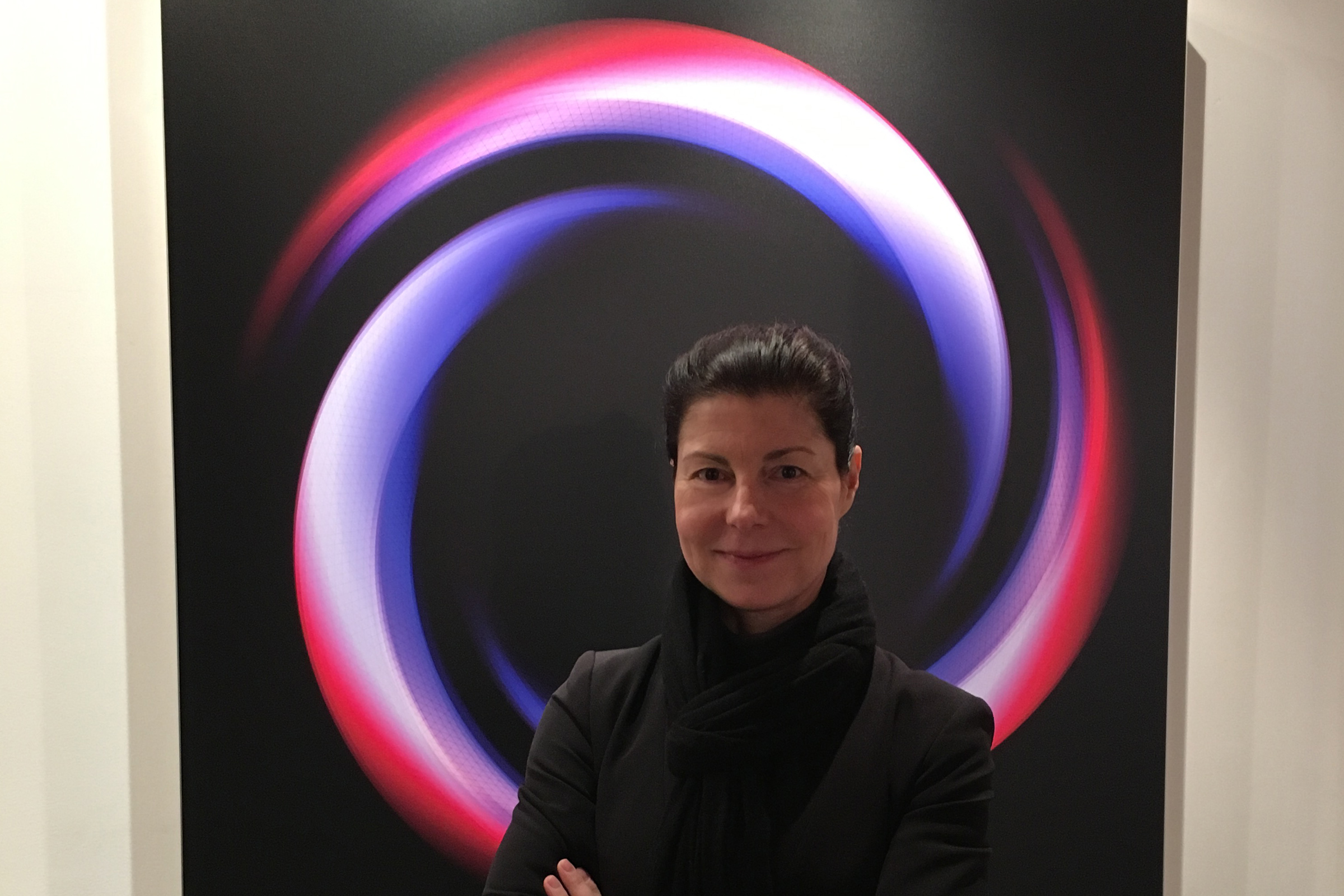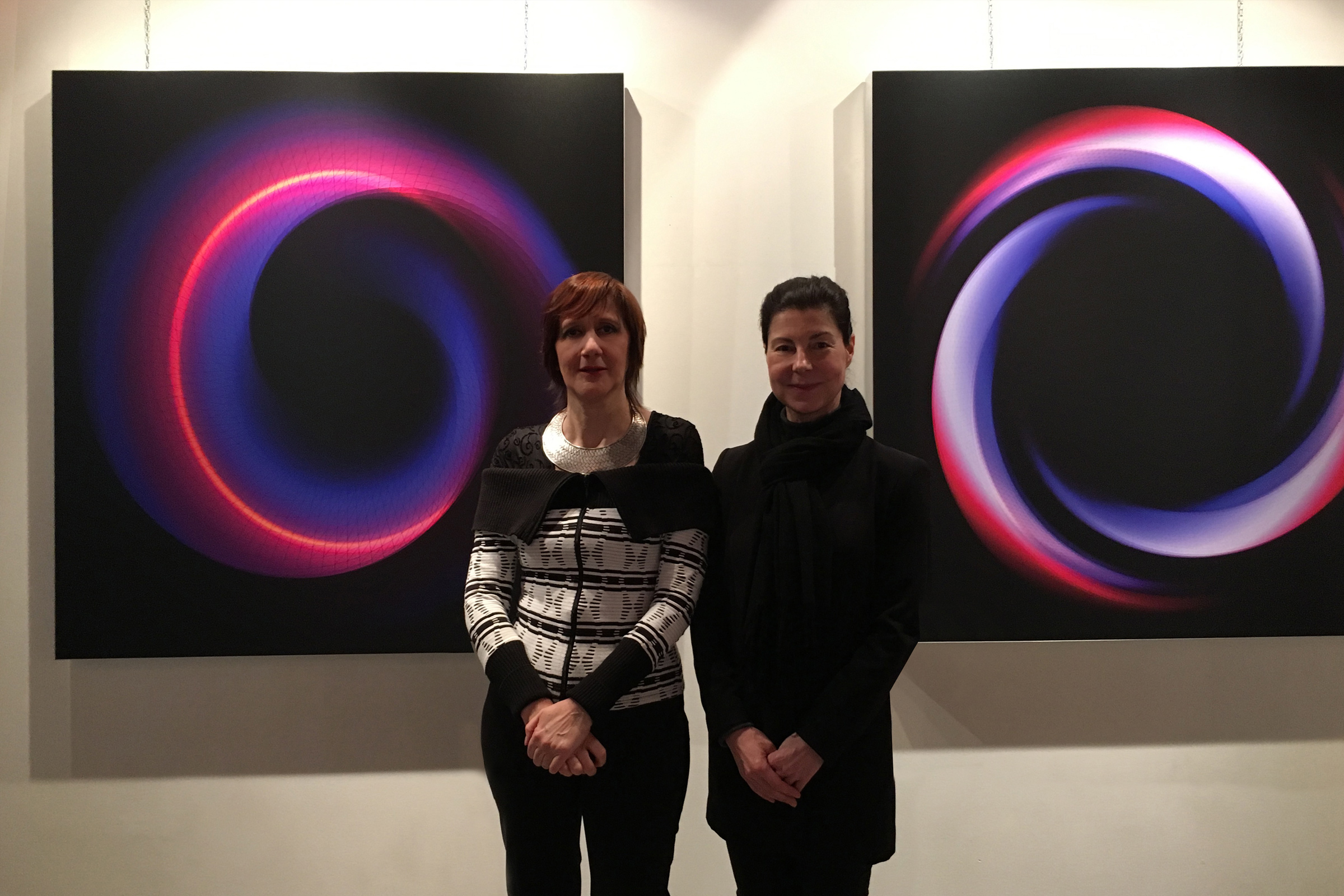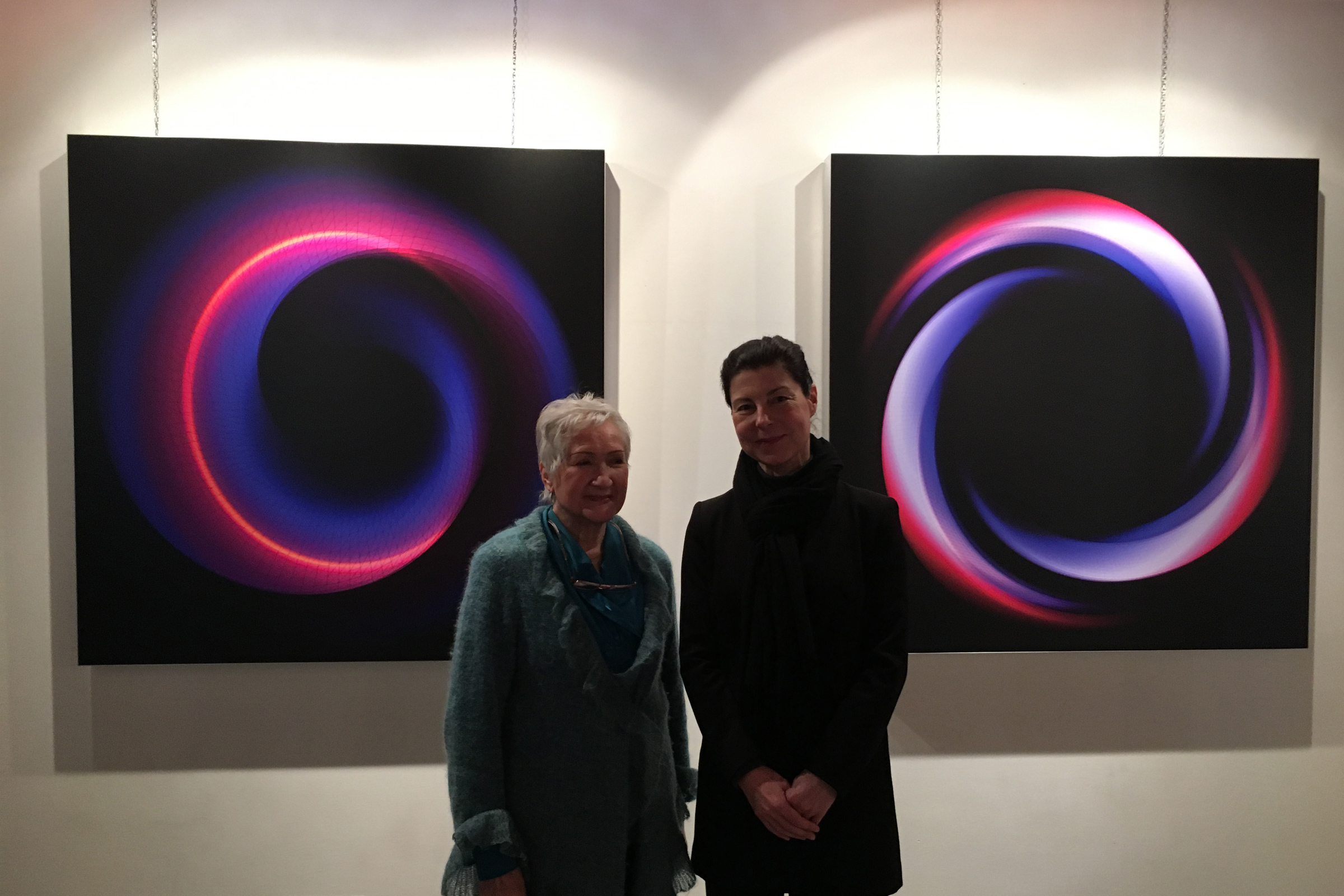Solo exhibition, May 10-August 2, 2019.
Excerpt from the catalog La Geometria Della Luce edited by Valmore Studio d’Arte and curated by Monica Bonollo
The image as a medium of knowledge
By Monica Bonollo
Bardula is an artist well grafted into the movements of the 20th century, from which she drew sap to bring forth the new expressive forms of the 21st. Her historical references originate from a number of areas, the most evident and closest being the complex paths of kinetic optical art. But in her constructivist approach, she also gets inspiration from geometric abstraction and concrete art. A reference could certainly also be made to Renaissance studies of the perspective device, to their theoretical premises and to their vertiginous effects in baroque anamorphoses and trompe l’oeil.
There would be much to say about the sources of the manifold contributions to be found in her output. However, it is certainly much more interesting and significant to try to realise how, from the accomplishments of the many artists that have preceded her, she has managed, by creating works of great visual and conceptual impact, to forge her own original way forward. Bardula’s output kindles our curiosity about her later developments, as if she were signposting glimpses of possible directions of future.
Her affinity with optical kinetic art is undoubtedly much in evidence. One is amazed by her profound knowledge of the work done by her predecessors, and by the wisdom with which she adopts the results of their experiments. Many of her works reveal echoes of Vasarely or Careaga, in her desire and ability to conjure a third dimension from two-dimensional works, depth from surface, and to highlight the ambiguity existing between pictorial space and that of the observer. Her command of colour and of colour-light is reminiscent of Garcia Rossi’s remarkable gifts, whilst her search for multiplied space and endless depth recall Paolo Scirpa’s ludoscopes.
Also fundamental is the artist’s concern for the observer’s point of view, for the importance of the relationship between the work and the spectator, by the complicity of the eye. The same work, viewed from the front and from the side, is transformed beneath our incredulous gaze.
In much of her output Bardula also develops a study of intrinsic movement. Her images are unstable, pervaded by a continuous vibration, in perpetual virtual motion (with echoes of Stein, Le Parc, Wilding and many others). Through her expert handling of the perceptive mechanisms and dynamics of vision, as researched in depth during the twentieth century by psychologists and artists, Bardula with the utmost subtlety bends to her own needs the latest innovative technologies (not only hardware and software but also the materials used) to accomplish unprecedented results that are also fully in harmony with her time.
Besides this rapport with her predecessors, Bardula maintains a close relationship with science. A dialogue between art and science, mediated by technology, seems to provide the most meaningful context in which to develop her work.
She engages in a confrontation with the major and still open issues of contemporary science, offering suggestions on how to continue that dialogue while hinting at possible further developments. But a foreword is needed here. Bardula’s work is backed by a profound knowledge of geometry and mathematics, which underpin her explorations of abysses: the known limits of the image and of visible reality. This is her personal quest for knowledge since there can be no knowledge without a language to represent it. We know moreover that for human beings sight is the favoured channel of interaction with reality. Visual representation is always the most effective idiom in the road to comprehension.
A few weeks ago, on 10 April 2019, a sizeable group of scientists showed the world the first image of a “black hole”. That image is the result of years of observations and processing of data, of following up and verifying hypothetical existences formulated only through mathematical calculations. A “black hole” is by definition invisible, in that it sucks in everything around it, matter and light, which due to the force of gravity can no longer get out. Since it emits no light, the black hole cannot be perceived through sight. Visible instead is the “horizon of events” that delimits it: the incandescent swirl of dusts and gases that spiral towards its centre, in a journey of no return. On this occasion it was said that “What we are seeing is proof of a horizon of events. Now we have the visual proof of a black hole”.
Black holes are today the most extreme entities imaginable. They represent the frontier of our knowledge of the universe, and with it, of reality.
So, Bardula’s work seems to focus precisely on the attempt to give visual form to what is invisible or hard to visualize and to find a language, a “technological device”, capable of doing so. The titles of Bardula’s works - “Atomium”, “Event Horizon”, “Beyond Hyperspace”, “Waves”, “Ice”, “Starry Night”, “Ripple” and “Möbius” - already refer to the world of Physics, from the atomic scale to that of the universe, from quantum mechanics to the gravitational theory of relativity. There is declared attention to atoms and molecules, organic forms and cosmic formations, and to the forces that act upon them, as also to forms and figures that represent them: “Purple Explosion”, “Carrés Etirés”, Carrés Eclatés”, ...
When dedicating works to her ideal masters, Vasarely and Le Parc, in “To Victor” she is visualizing Einstein’s time-space fabric, and in “Hommage à Julio Le Parc”, she is staring into the face of the “monster”, the “black hole” and the “unknown”. “Interference Bleue – Hommage à Le Parc”is a visual representation of the power and uneasiness of our knowledge.
Try fastening your visual attention on the centre of the image, or its edges. Both are in constant motion, incessantly transformed. The spectator cannot keep their eye on them, because their gaze is continually diverted towards other points. If we stare hard at the monster, the abyss dilates, eating up part of the colour; the edges shrink, making the figure smaller. And the whole figure is swept by the movement of a slow but inexorable wave.
The originality of Bardula’s art lies in her attempt to survey and to represent the complexity of the concept of space, at every scale and in all its accepted meanings. This occurs from geometric and mathematical space used as a medium to architectural space (with reference to the sculptures and installations), in which she reflects on the elements and on their relationships to build a three- dimensional space, an environment in which light is fundamental to its structure.
Where space is intended as a universe, as what constitutes reality, as what we know about reality and what we still don’t. Hyperspace, the beyond, is treated as the desire to reach beyond the known universe, to discover new dimensions and fresh “forms” of existence.
The passage between dimensions, from 2 to 3 and 3 to 4, and beyond the fourth towards other hypothetical dimensions, also represents an arduous cognitive leap. What is inside or beyond the black hole? Is there a passage to other dimensions, towards other universes?
And what makes Bardula’s works so vibrant and constantly transformed is her keen awareness that space is not immobile, cannot be separated from time and is therefore pervaded by movement.
We should also reflect on the question of light, which plays an essential role in Bardula’s works. Light is deployed as energy, as what lends form to matter; and also as an electromagnetic wave that enables us to perceive our surroundings. Light is intended as a possible means of knowledge.
Bardula’s works contain a remarkable force of attraction, a vertiginous attraction towards the unknown, with a curiosity that propels us beyond known space. Through the most rational media at her disposal - mathematics and geometry - she leads us into the unknown, in order to survey it or to bring it into view.
She does this through interacting and contrasting pairs of opposites: light- darkness, surface-depth, external-internal, visible-invisible, known-unknown. Rationality, the surface, the visible and the known world relate to depth and darkness, the unknown. Our certainties, our equilibrium and calmness, are constantly confronted with the uncertainty, trouble and imbalance caused by the awareness of the limits of our knowledge.
Her work titled “Ouroboros”, with the snake biting its tail and the circle without a beginning or end, is seemingly immobile. But it is actually in everlasting movement, representing the universal energy that devours and regenerates and forever consumes and renews itself, in the unity and totality of everything. What is Bardula’s new contribution to the geometric-constructivist approaches of the 20th century? The artist’s point of departure is no longer to pit objective methods and techniques of representation against individual and subjective expression. Hers is an attempt, situated at the intersection between different disciplines, to join their forces in pursuit of fresh avenues and to suggest hypotheses.
Through the principal media of rationality, mathematics and geometry, Bardula ventures to the very limits of reason and knowledge, towards other possible dimensions of existence.
Valmore Studio d'Arte was founded in 1995 by the director Valmore Zordan and by her passion for contemporary art in the second half of the twentieth century, especially for those movements that changed radically the concept of work of art.
The choices of the gallery focus on artists who develop deep and serious research, rooted in the scientific discoveries of their time, and create objects and situations from experimentations realized also by more and different personalities (groups).
Valmore Studio d'Arte has artists from the historic international groups of Optical, Kinetic and Programmed Art, artists of the Analytic Painting, artists subscribing Spatialism, historic Visual Poetry, Video Art and Electronic Art.
The intent is often to propose artists with an interesting historical past, known and appreciated by careful criticism, but not always sufficiently appreciated by the art market.
Thanks to the coherence and attention to the cultural value, Valmore Studio d'Arte is an international reference point. In fact, in addition to the regular exhibition activity, the gallery has co-operated for a long time with governments, museums and important cultural institutions all over the world.
Care, reliability, coherence in the choices and concreteness in the proposals make it possible to influence the market without being conditioned, regardless of the mode, and allow to gain credibility over time.
